
Adora, Adora Seedless (Sugra 34), Aledo, Allison (Moyca), Alphonse Lavallee, Arra 29, Arra Passion Fire (Arratwentynine), Arra 31, Arra Sweeties, Autumn Crisp, Cardinal, Candy Dreams, Chasselas, Crimson, Cotton Candy, Dallac, Danlas, Early Sweet, Fantasy, Flame, IFG Three, Italian Beauty, Itum 5, Itum 15, Ivory, Jack’s Salute (PLU 3496), Jacques, La Vallee, Madeleine Angevine (Mad Ange), Mazzarrone, Midnight, Midnight Beauty (Sugra 13), Muscat Beauty ( Rosada), Muscat Bio, Muscat Bleu, Muscat de Hambourg, Muscat Oeillade, Muscat White, New York Muscat, Natorra, Orchidea, Prima, Prime, Phonix or Phoenix, Punnet, Raisin Rose Vrac (Charlotte), Ralli, Red Globe, Regal, Sable (Sugrasixteen), Scarlotta, Starlight, Sugarone (Uva Senza Semi), Sugra 48, Sweet Celebration, Sweet Globe, Sweet Joy, Sweet Sapphire, Sweet Surrender, Superior Seedless, Tawny (IFG Candy Hearts), Timco, Timson, Tutti Fruiti (IFG Candy Hearts), Vitoria, (54 varieties)
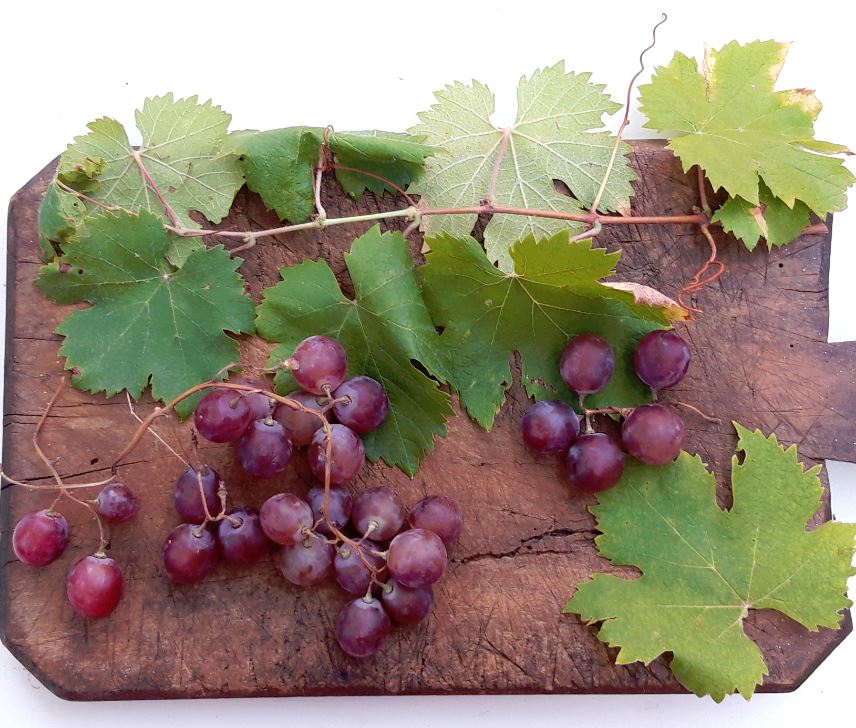
Reviewed here are a selection of grapes, either grown in the author’s garden, or purchased in the UK or France. They are to demonstrate the huge BIODIVERSITY and VERSATILITY of the hugely VIGOROUS Vitis vinifera species. Grapes are loosely classified as white or black, but the colours vary enormously. Enjoy!
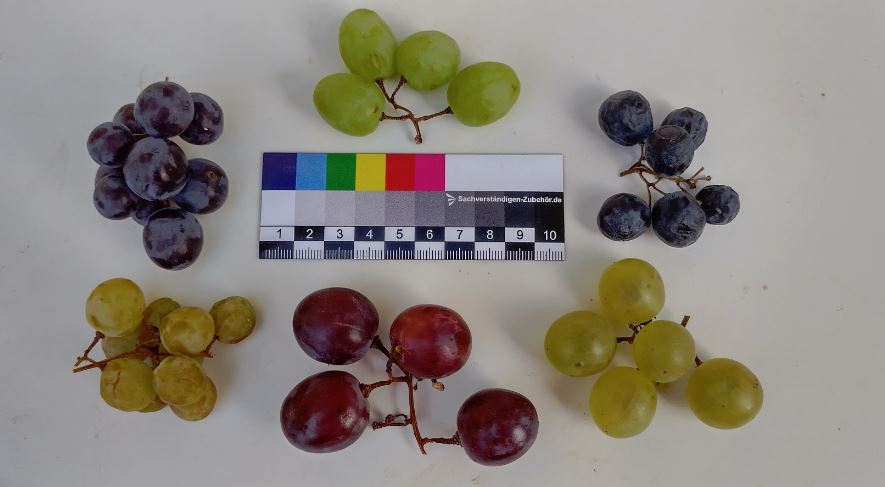
Grape Variety: Identification right-handed from top centre: Sugarone, Muscat de Hambourg, Dallic, Cardinal, Chasselas and Muscat Bio
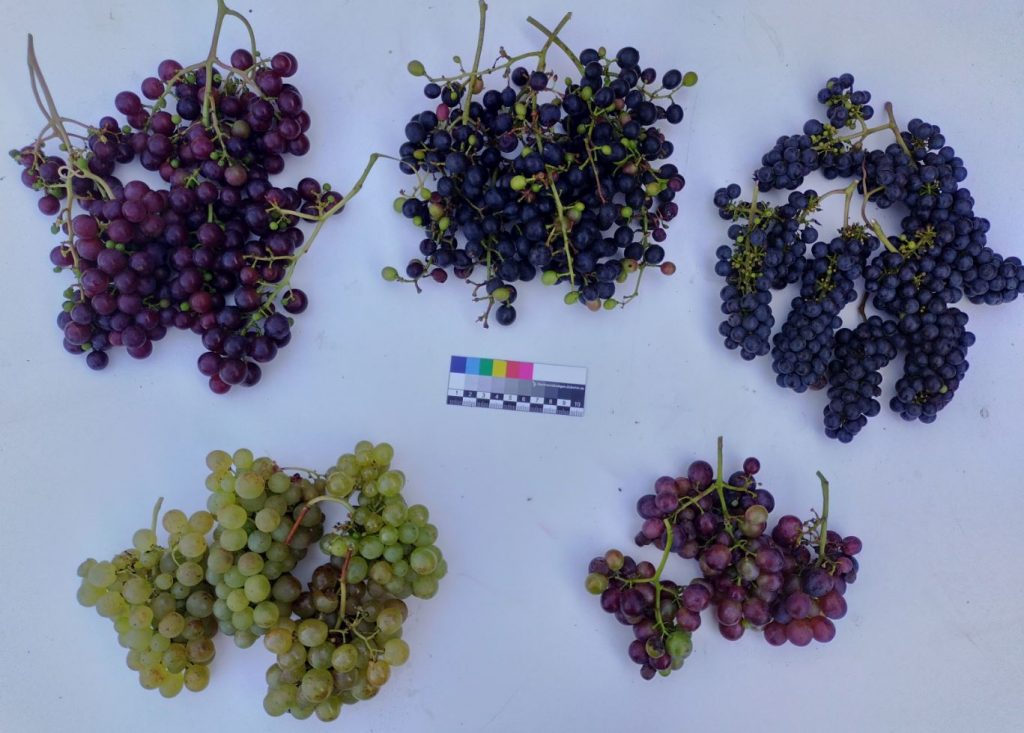
The colours of grapes are so variable, from green through purple to blue-black.
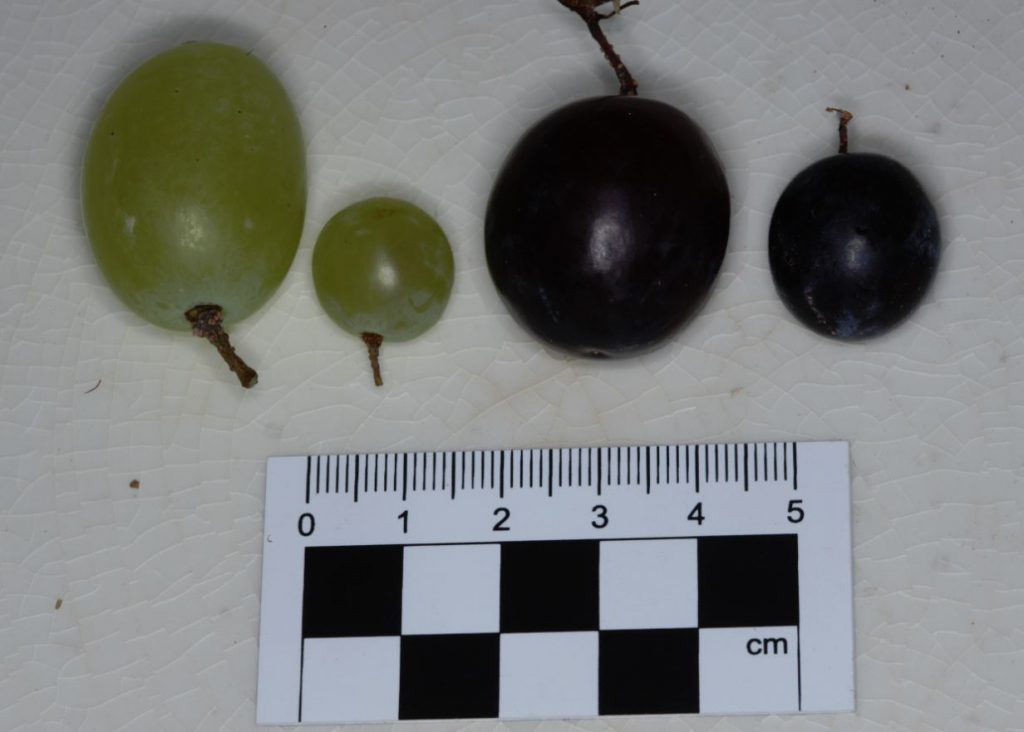
Grapes comes in all different shapes and sizes: (L-R)
Victoria, Chasselas, Cardinal, Muscat
They also range from small grapes to large grapes, to grapes like small plums and weird-looking grapes. The taste varies from completely bland to mouthfuls of pure pleasure. The modern trend is to grow grapes without pips (seedless) but there is nothing quite like popping grapes in the traditional way and spitting out the pips, particularly under a Mediterranean sun, either in the Mediterranean or under the warmer skies of the UK, as the Roman enjoyed – well they had vineyards, how much they enjoyed a bunch of grapes is less documented.
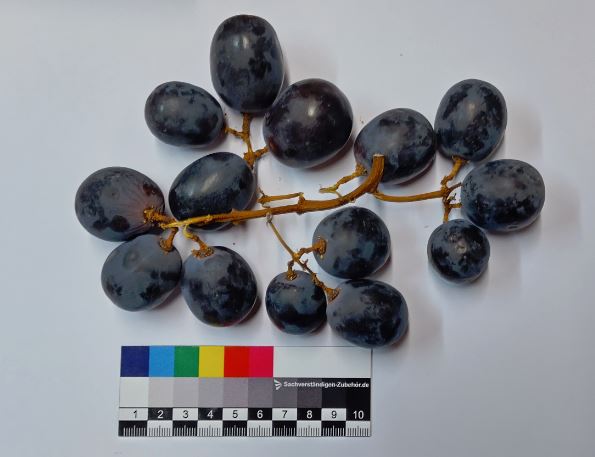
‘Adora’ – some plums are smaller than this huge black seedless grape. The purple skin in very tough and very chewy that takes away any pleasure from the green flesh. This grape is so large it takes 2-3 bites to get through it. It is so hard I suppose it could be sliced in a cocktail. Pity there is not a spittoon for this one. Origin Chile for Ocado / M&S. June UK.
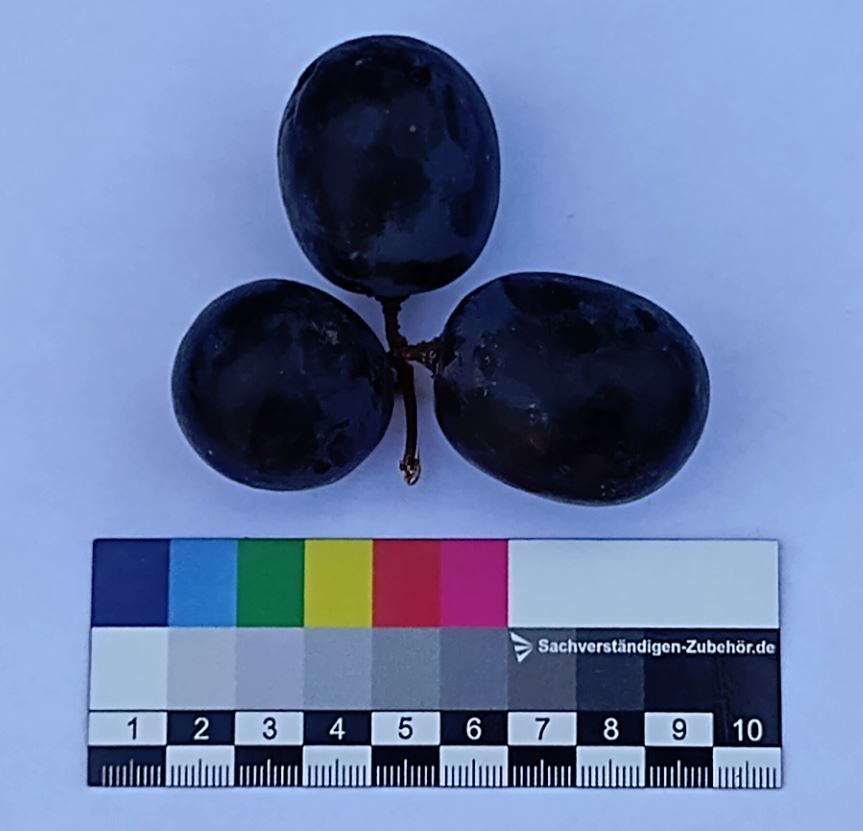
Adora Seedless (Sugra 34) The blurb on the packet says ‘black seedless grapes grown for a burst of deep, rich sweetness’, well I can attest for the rich sweetness, deep maybe. This sample had withered stalks indicating age, but age sometimes comes with increased sweetness. Chile to the UK is a long way. But the most remarkable items about this Adora is the size of the grapes. Large and small even on the same bunch. which is very unusual. They can be just over 4cm long and wide at the same time. On the scales they top out at 25grams each. The flesh cuts to a colour of a kiwi, a pleasant pale green. Overall a tasty grape, as large as a plum, but not quite up to being plum-delicious. Clearly there is more to Adora grapes in terms of the genetics and breeding (see the previous item, which is much much smaller, under the same name). Origin: Chile for Tesco, June UK.
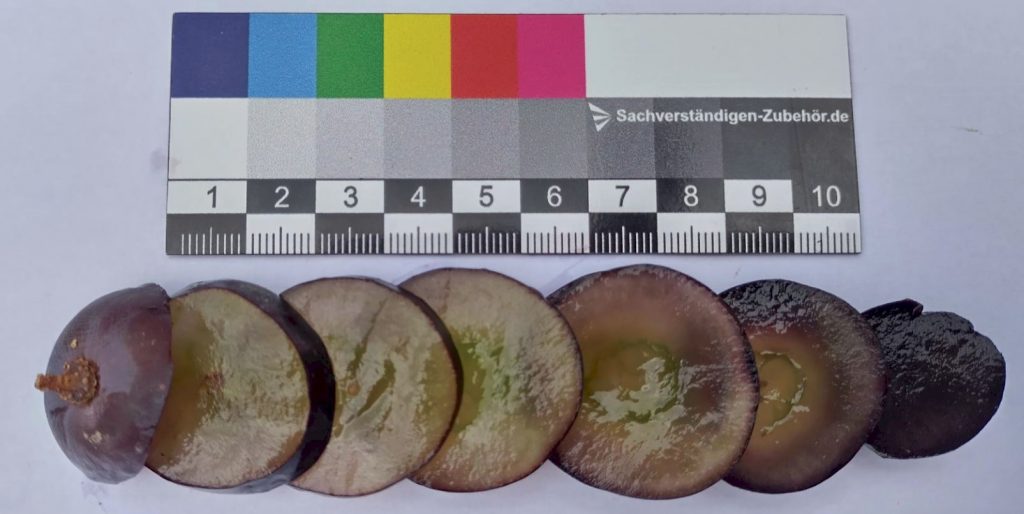
Adora Seedless (Sugra 34) – as above, sliced
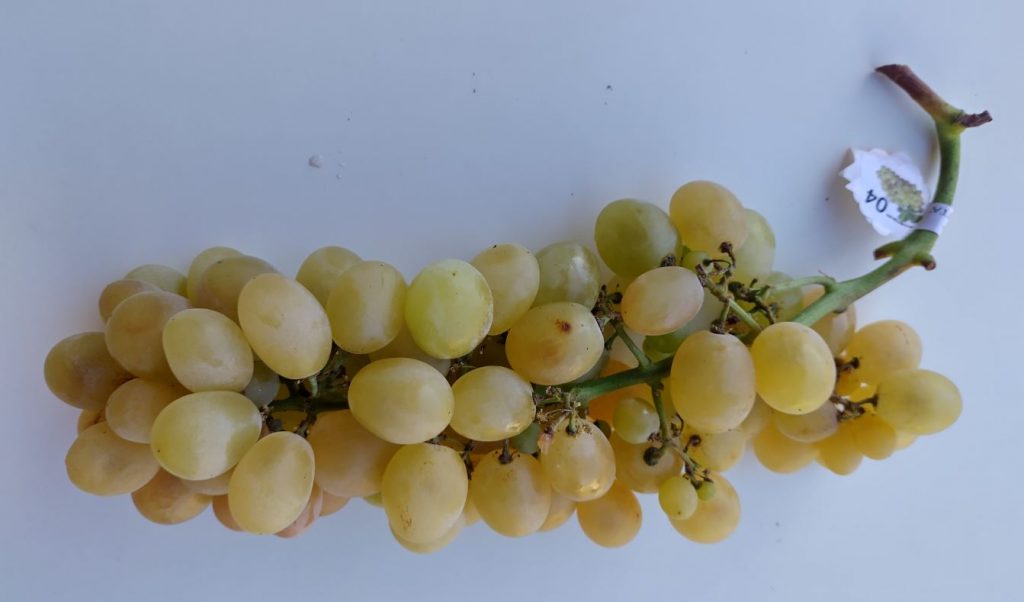
‘Aledo’ – a surprisingly excellent white grape from Italy, larger than the often named ‘Italian white’ grapes. It is actually a green grape that turns to dull orange with age and it becomes softer and juicier, even squashier and explosive. It has a few pips, but this is no hindrance to the flavour.
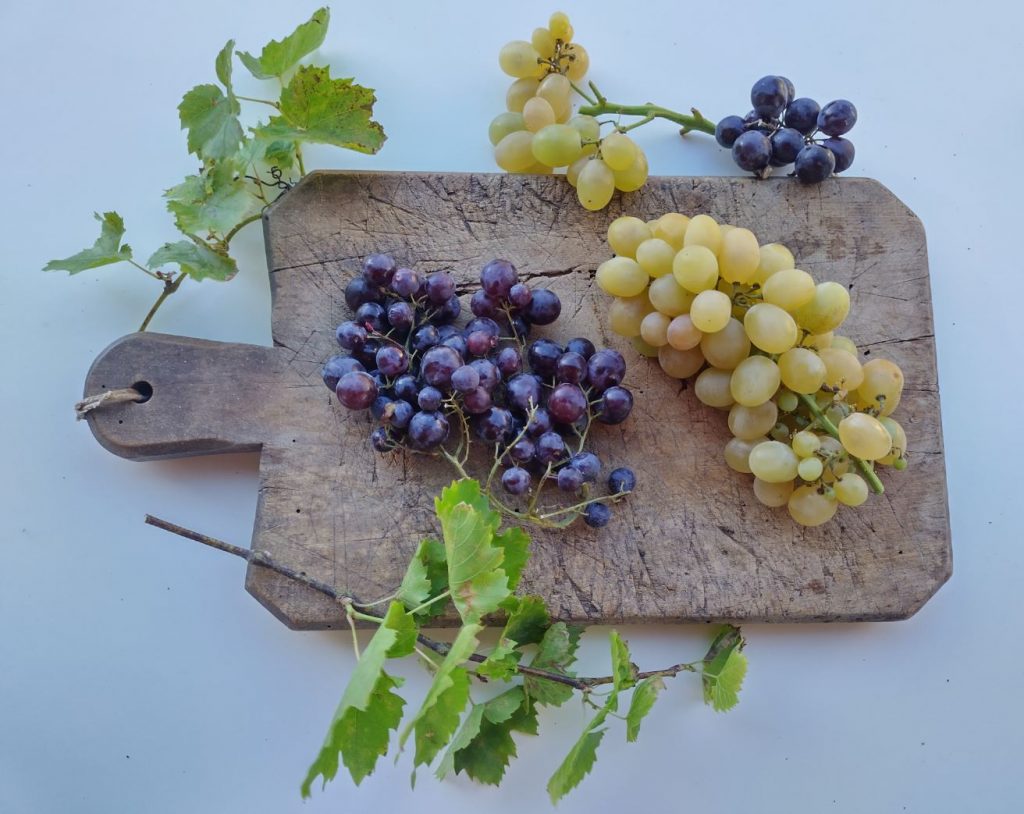
‘Aledo’ – When eaten alongside a Muscat de Hambourg, this white is a match for being one of the best whites sampled. It holds well in November for being picked and stored a few months earlier. Origin: Italy for Aldi in France, 34.
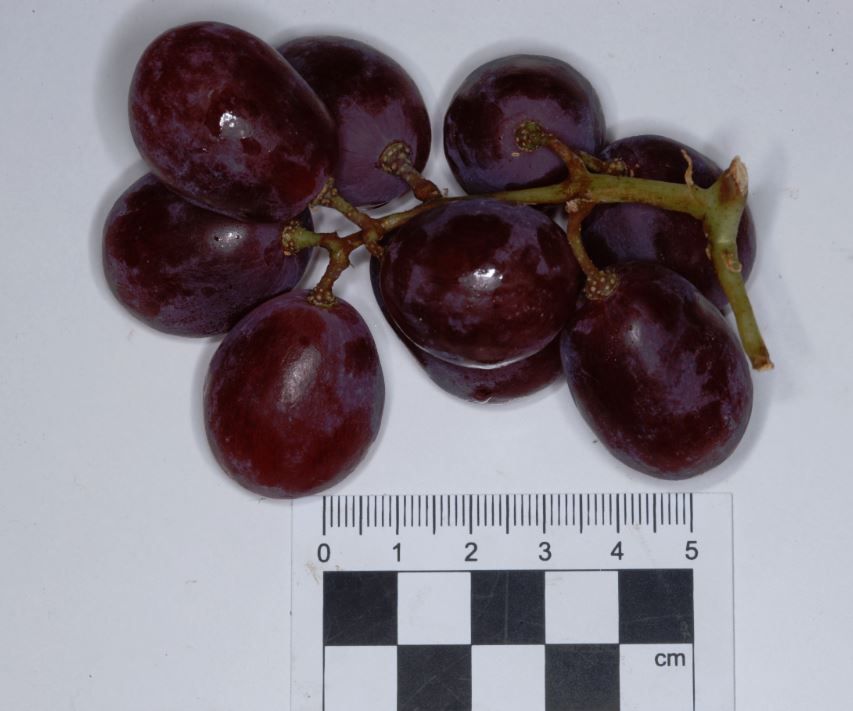
‘Allison’ also called ‘Moyca‘ a nondescript seedless red grape. Quite a widespread table grape. Fruit is slightly oblong, skin is firm, and overall slightly better than average food for bedside popping. Origin: Sainsbury from Spain. Other Origins: Chile and South Africa.
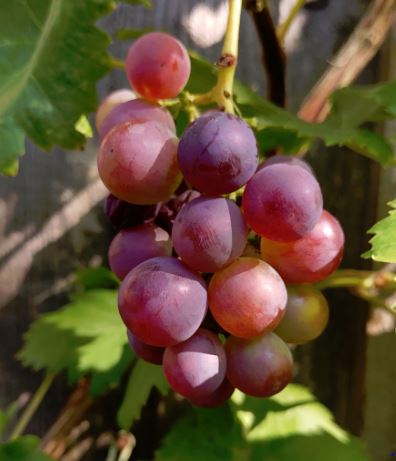
‘Arkley’ – an unknown grape named after an English village where it was found. A pink seeded grape, maturing well into late autumn with darker tasty fruits. Grown in East Sussex, UK
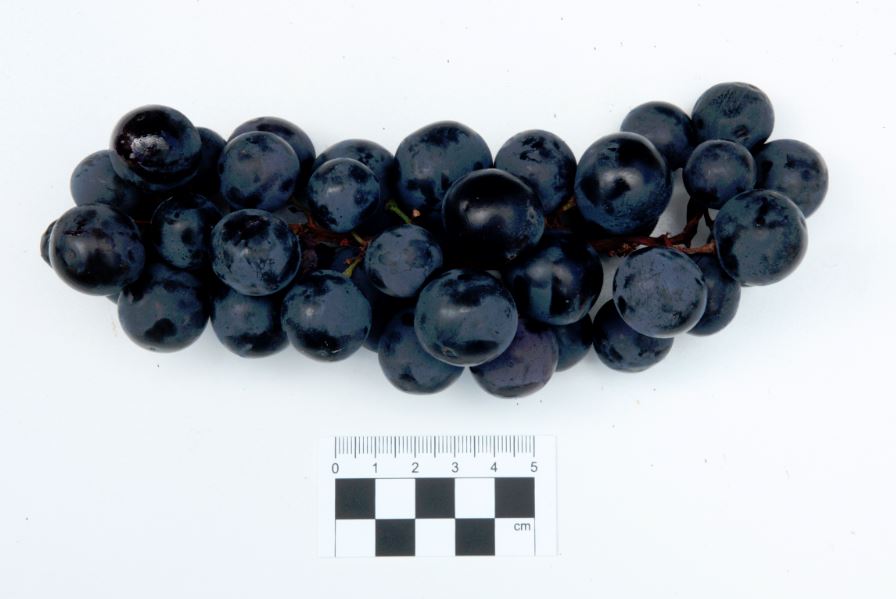
‘Alphonse Lavallee’ a very small ‘raisin noir‘ grape, seedless, well rounded, fruity magic parcel of sweetness, taste of sweet strawberry jam. Solid jam within a skin.
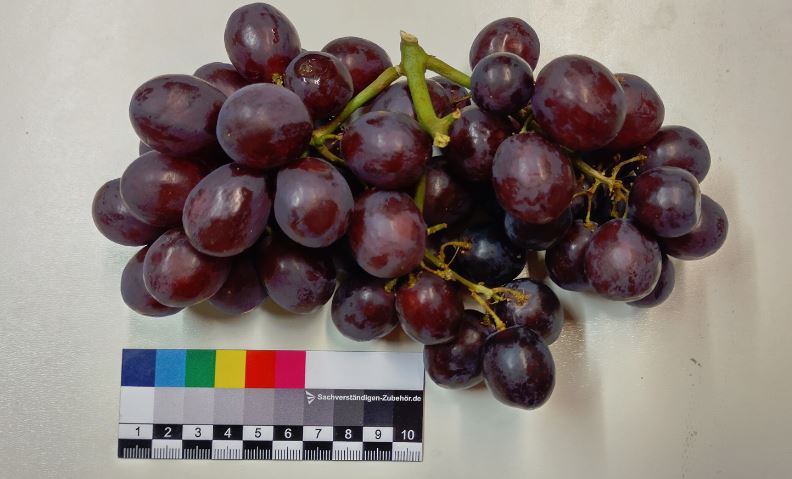
‘Arra 29’ -A perfectly acceptable black seedless grape, slightly elliptical, whose soft skin and juicy flesh do not leave any unacceptable taste, aftertaste or buccal debris. This is good score for a table grape which can be popped until full. These grapes are fresh with green stems. Origin: Namibia for Jack’s for Tesco.

‘Arra ‘Passion Fire’, or ‘Arratwentynine’ (obviously) from a different source to above. On green stems this is marketed as a red seedless grape, sweet and juicy’ which I would agree with. The grape is rounded and pale purple even cherry colour to dark purple, soft and squashy with a very pleasant ‘eat’, the skin is not troublesome, the flavour agreeable. Very moorish. Could sit and eat these for a long time. Origin: South Africa via Lidl, Bexhill, Sussex.
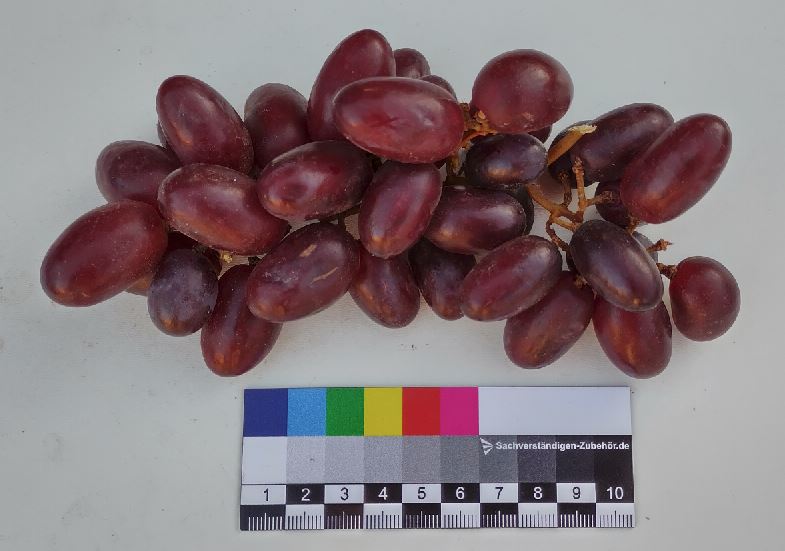
‘Arra 31′ A rich purple to dark purple seedless grape with torpedo-shaped fruits with no pips. Somebody might like this. The flesh is firm and juicy. The origin is Brazil but it has come too far to be sold in a local Sussex Post Office, for its stems are withered and brown not green and succulent. The sales tag says this is ‘part of the Tesco family; sold under the ‘Jacks’ label. Fresher ones might be better.
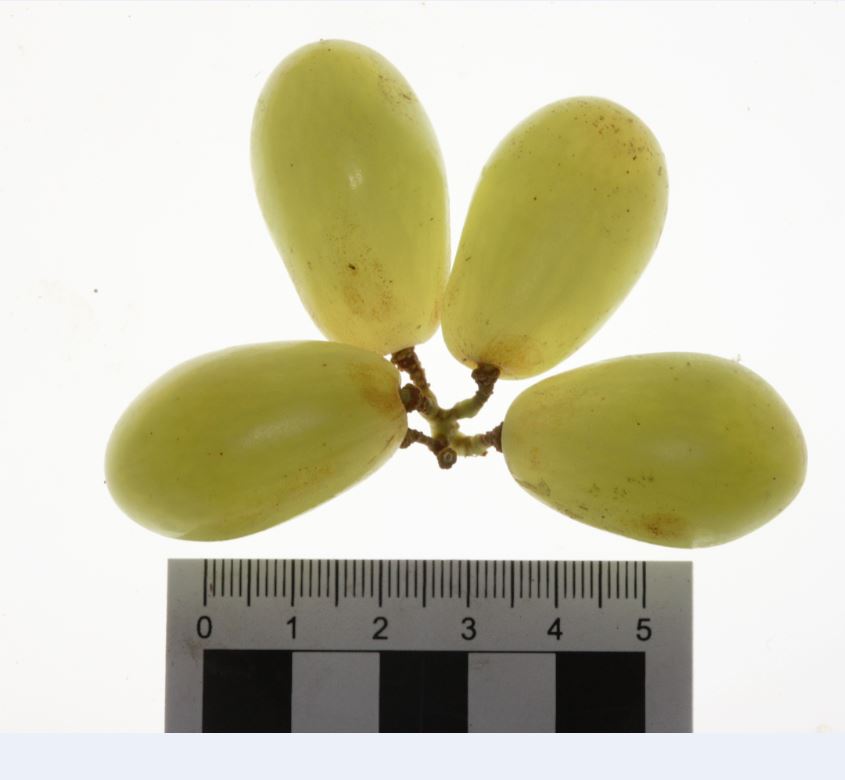
‘Arra Sweeties‘ A white seedless grape with firm skin, verging on oblong, flesh OK, not bouncing with sweetness. Not too impressed. Origin: Brazil for Sainsburys from Coana.
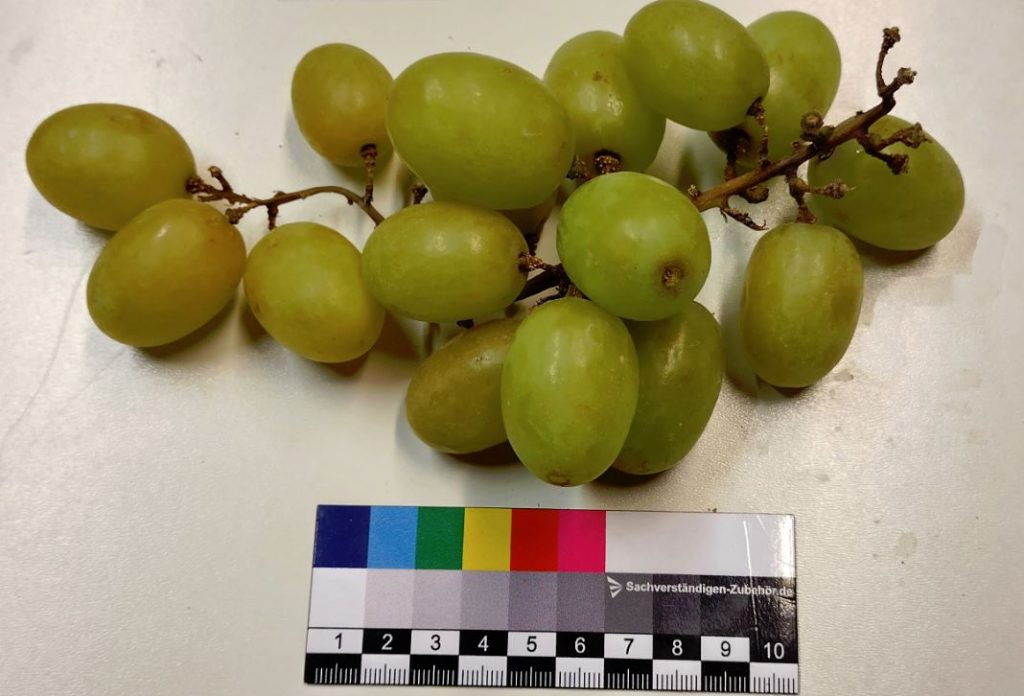
‘Autumn Crisp’ – a large (over 3cm) white (actually green) seedless grape, with firm flesh (nondescript); skin, light, firm, aging to pale orange. It is quite a straightforward acceptable hard grape which keeps it juices firmly inside. The grape itself is so turgid that it can be cut into thin slices, if you know what to do with it thereafter. Origin: Peru for M&S. South Africa for Ocado (in April) – which begs the question why an Autumn Crisp grape in the Spring. Southern hemisphere delights.
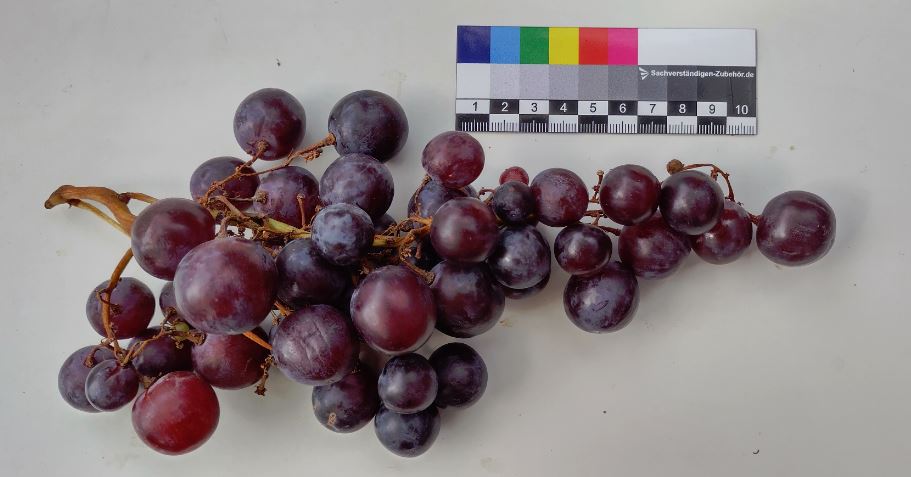
‘Cardinal’ – a mass-produced staple which saturates the markets in the South of France during August. It’s a standard grape which is an all round undistinguished favourite. Very pleasant, not too juicy with sound flesh. Origin: Market in France (34).
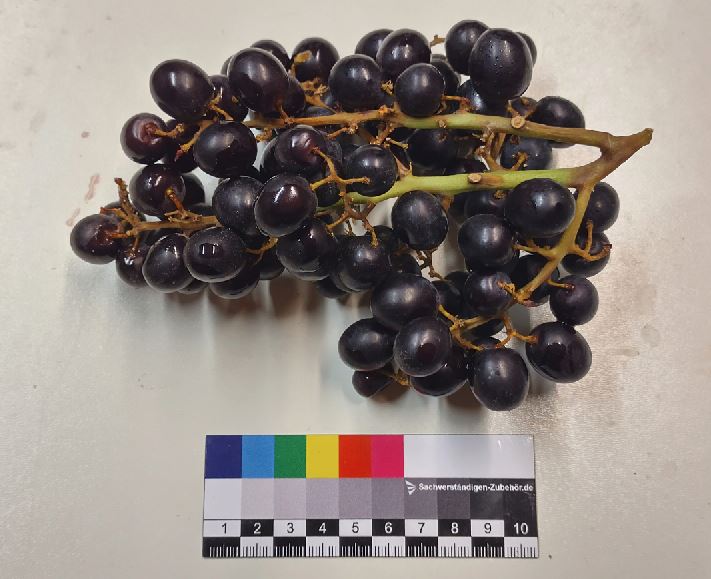
‘Candy Dreams’ – marketed as tasting of jam, this is a small black seedless grape which is very fruity, but not necessarily juicy. It has bright, young sweet taste and presents as a collection of unusually small grapes – they are about the same size of sloes, not not bitter. Travel time seems to have caught up with it, showing fresh green and older brown stems going off. Origin: Peru for M&S.
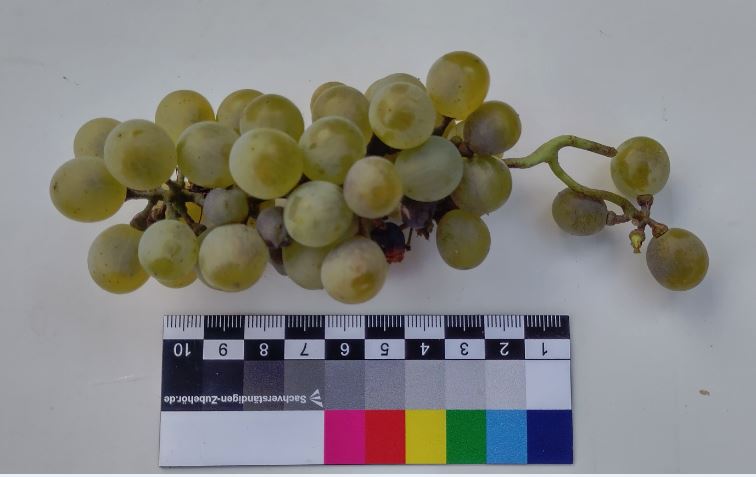
‘Chasselas‘ a very popular and vigorous vine with seeded grapes. A later maturer in England, and the fruits change to an orange glow when at its best. Quite a small grape that stores for a short while and tempting to eat in quantity. A mature outdoor vine easily produces over 60 bunches when kept irrigated.
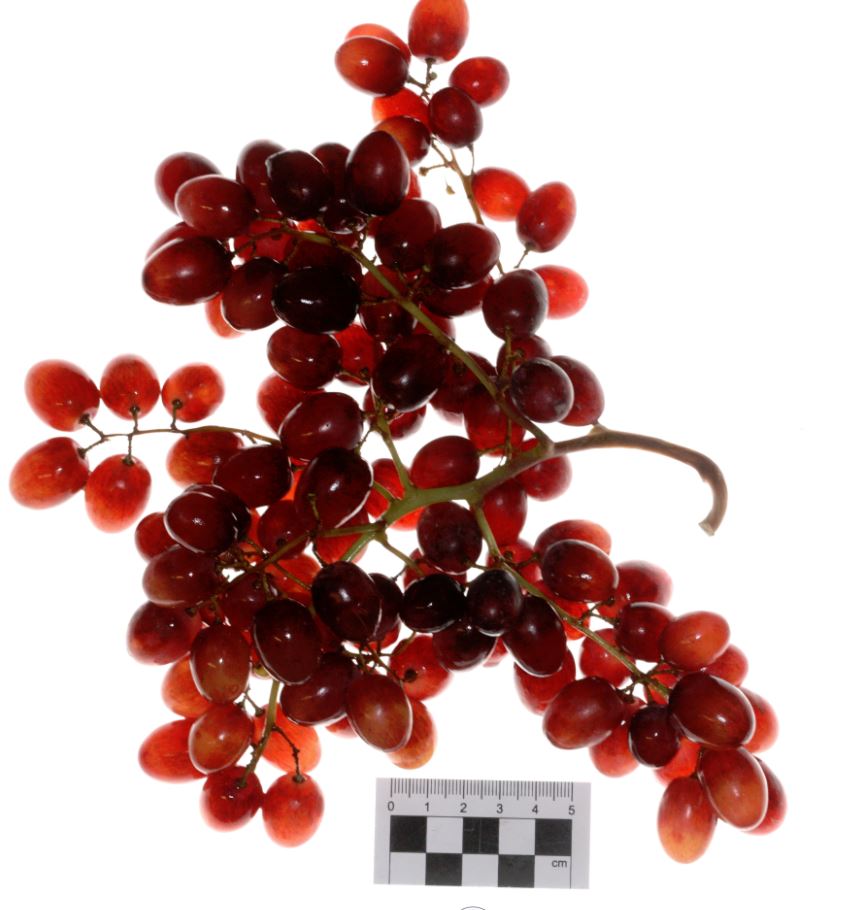
‘Crimson‘ – a variety suitably named, a light reddish, variable coloured grape, seedless. Very juicy, up with the dark muscats, very moorish, the flesh tasting like raspberries and summer fruits. Origin: Greece for French Supermarket (Fr, 34) via Zeus distributors. South Africa for Ocado.
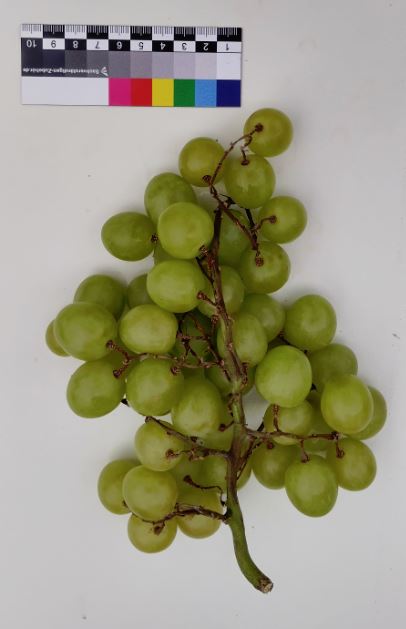
‘Cotton Candy’ –alluring to a sweet confectionery, this is a white seedless grape, of robust and noble fruit. The grape is slightly larger than normal size, round and full of sweetness. The variety too at least ten years of hybridization selection in test tubes, and the result is a grape that has slightly more sugar in it than normal. It is therefore exceptionally sweet, and even better when you wait until the green grapes go slightly orange, It is now marketed throughout the world. Source: Waitrose, UK.
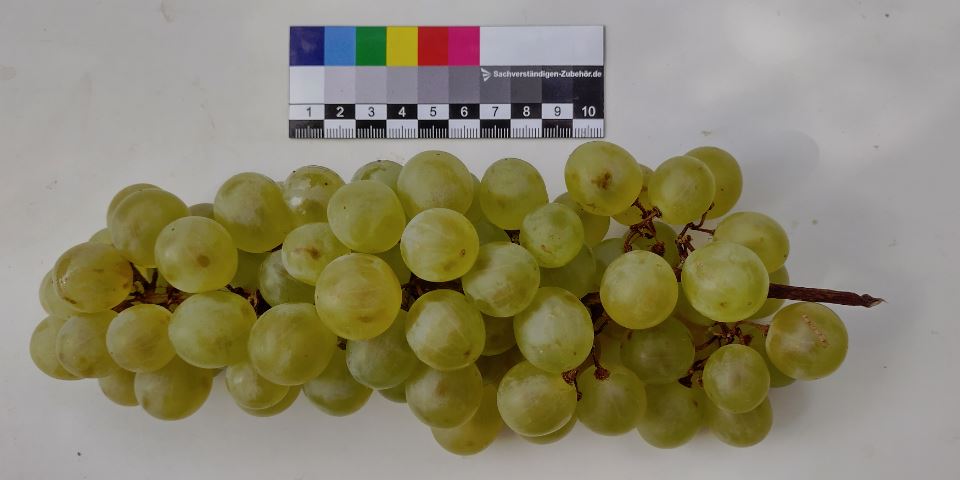
–
‘Dallac’ – A white grape with pips, very pleasant, skin not too tough, watery warm flesh, less on the sweet side but refreshing. Very worthwhile for the table or bedside, flesh slips out of the skin. Orgin: French market (34) locally produced.
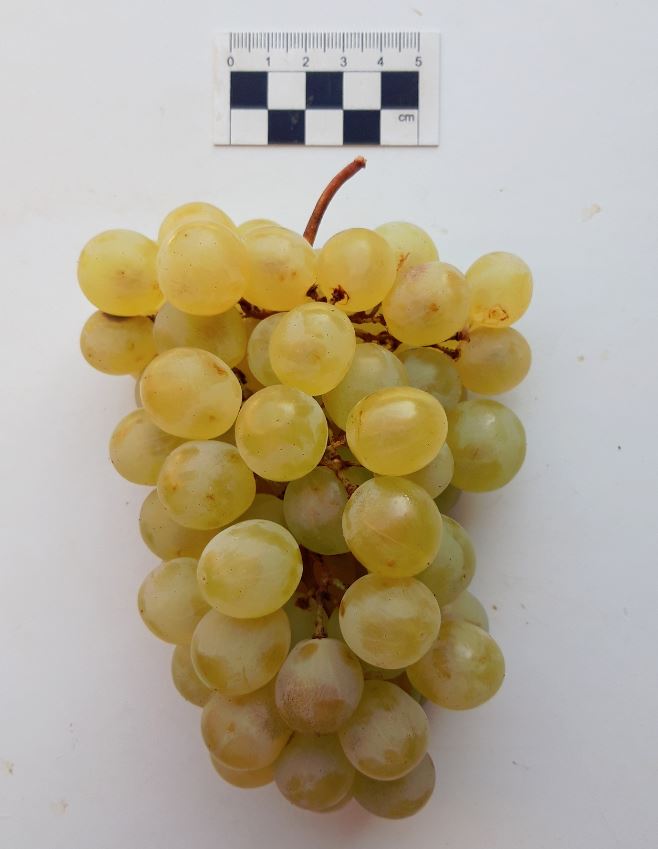
‘Danlas‘ A white seeded grape with small insignificant pips, a very pleasant mouthful of very sweet and juicy flesh. Skin is fairly innocuous, but after 5-10 grapes it does collect and need swallowing (for roughage) or spitting out. Overall experience: Excellent. Origin: Local producer, Le Vigan market, France, Gard (30)
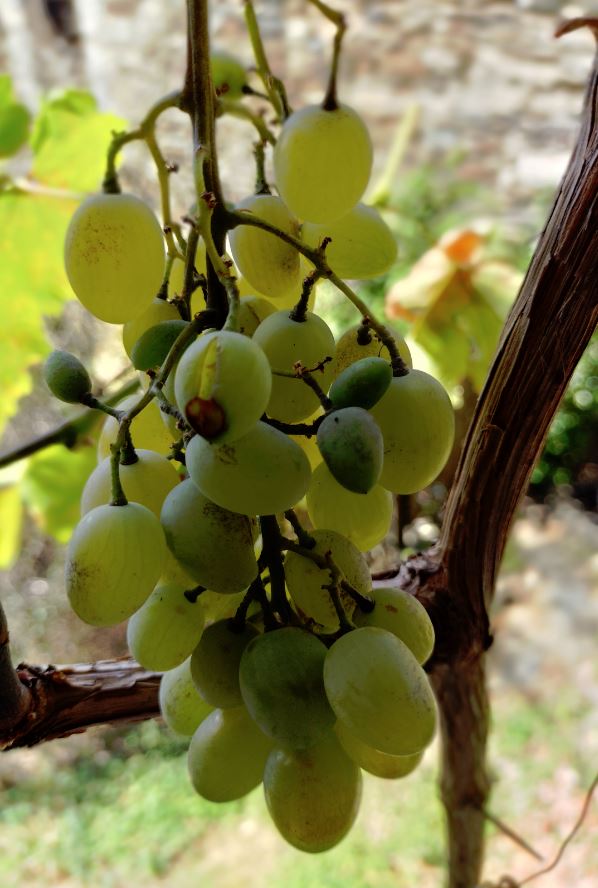
Danida – A white seeded grape, small and rounded, with too many pips to make a pleasurable experience., up to four pips per grape in this sample tested. Skin is too tough and needs spitting out. The flesh is OK but you cannot pop lots without having to deal with mouthfuls of pips and skin. It is OK as a locally produced, market stall produce, a good grower to ten feet in two years, with large bunches. As a table grape choose something else. Origin: grown in France (30) from market purchase.
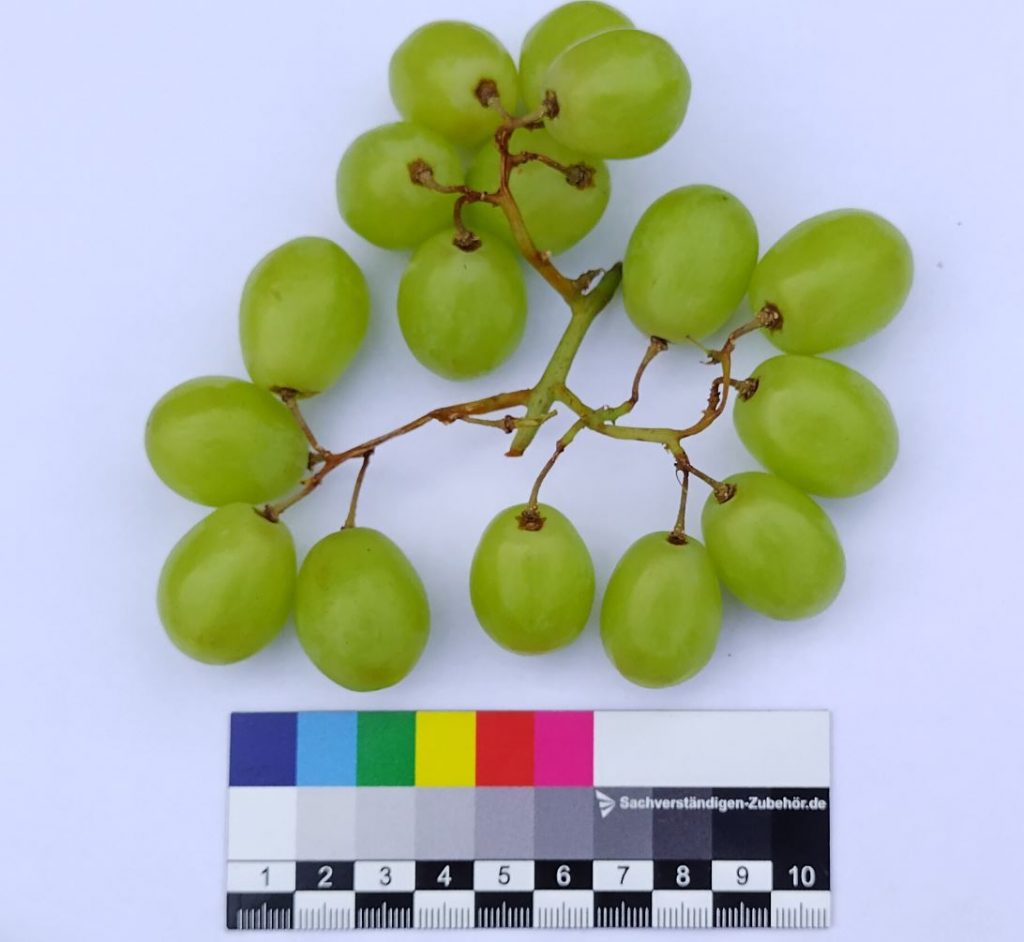
‘Early Sweet’ – A very clean-looking almost perfect seedless table grape, with fairly juicy flesh and light skin. Keeps well, even with green stems. Very poppable. Origin: Egypt (Magrabi), for Sainsburys.
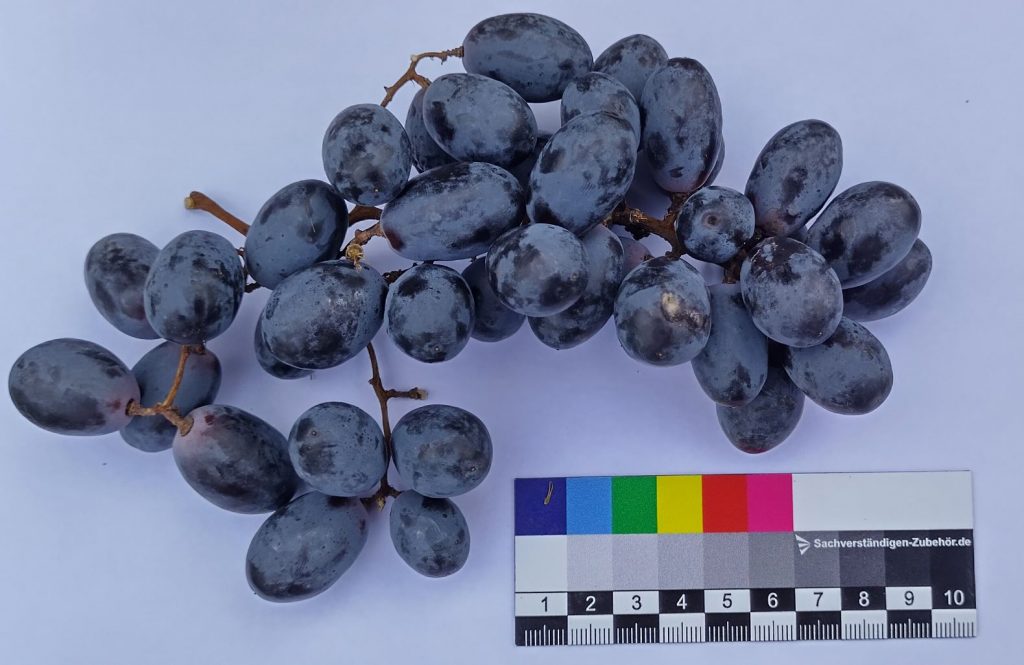
‘Fantasy’ – a black seedless grape but coloured light blue because of all the surface fungi. This sample had dark withered stems but were still surprisingly tasty. Origin: India (Krishirath), for Sainsbury’s.
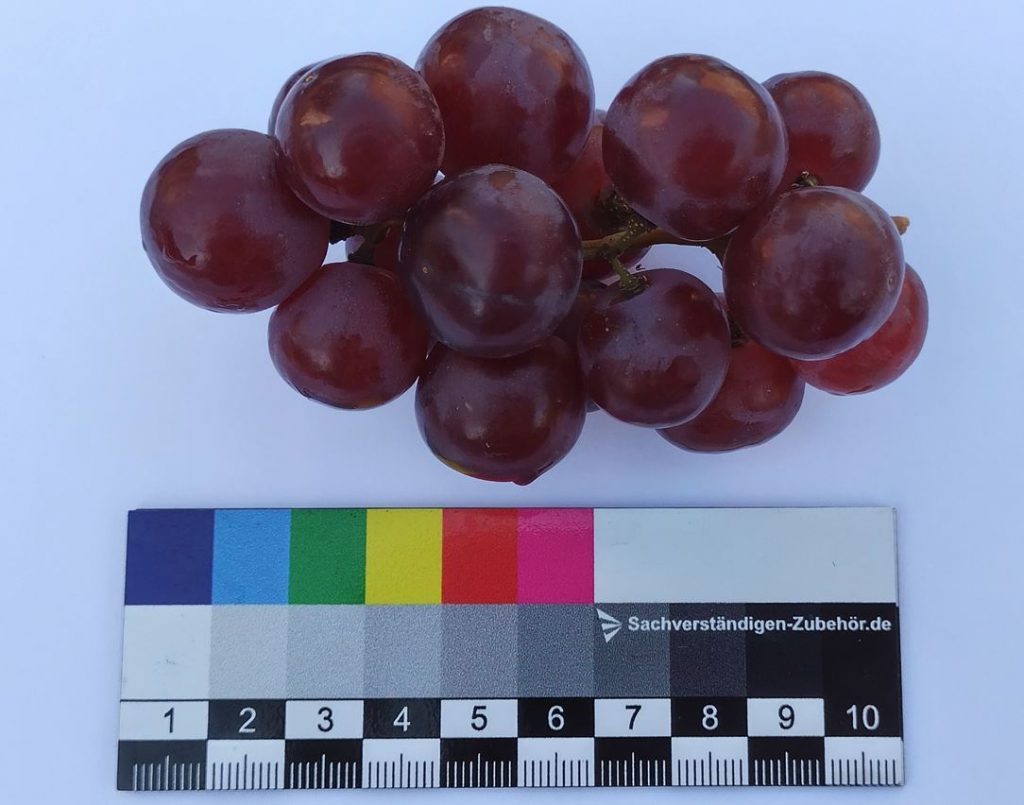
‘Flame’ a small dark red seedless grape, round and juicy, the skin is a little tasteless, very slightly bitter, flesh adorable but not enough of it. Need to pop lots. Available in July in the UK from Egypt in at least M&S and Sainsburys (2022) and Jempsons (2023). Also now available in UK nurseries as a garden plant.
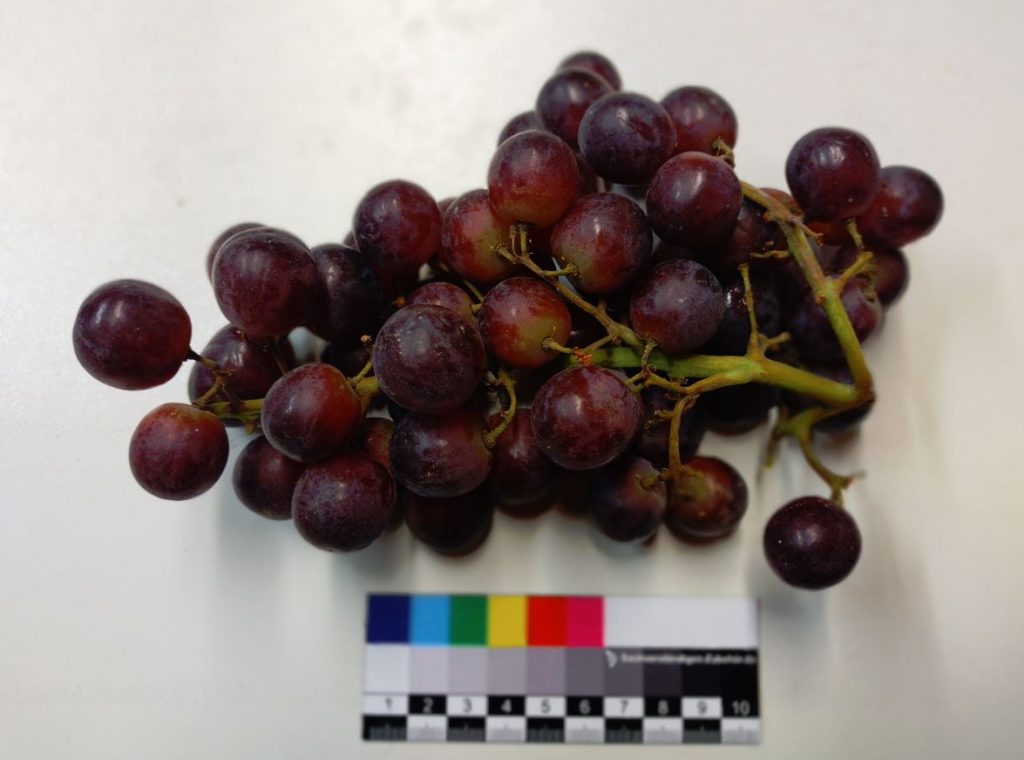
‘IFG Three’ – what a weird name for a grape, but this is quite a bold and sturdy black seedless grape forming big trusses. The colour varies from rosy dark purple to deep purple. The skin is not too tough, the flesh agreeable and watery but there is some unpleasant aftertaste. This particular bunch is covered in mould, perhaps a bit too old although the stems are green. Origin: Peru for Jack’s and Tesco Ireland, purchased in a UK Post Office.
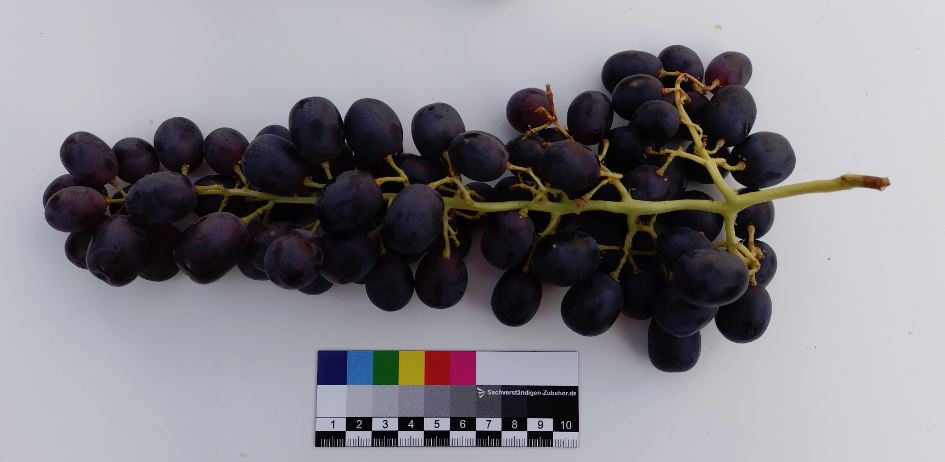
‘Italian Beauty’ a black, seedless grape, sold in an Italian bag which proclaims ‘ An old time favourite’ by Messina company. It is a very ordinary and bland grape with no sweetness. However, they look good, and the stems are green, indicating freshness. Source: Staverton Nursery. East Sussex.
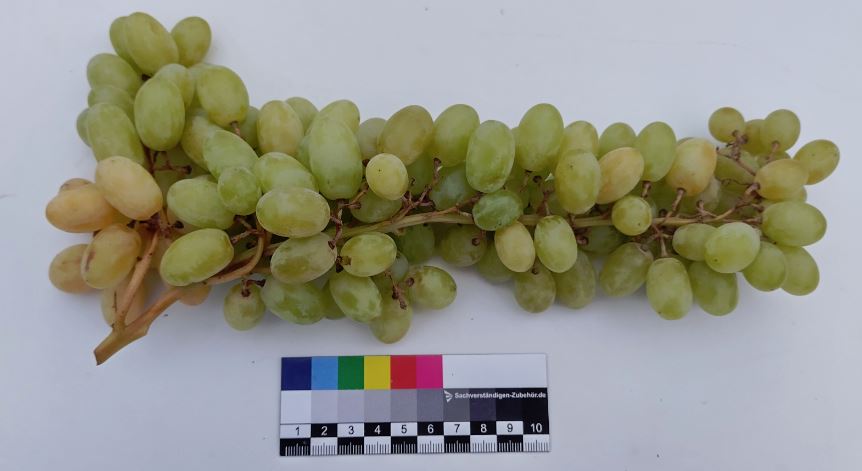
‘Itum 5‘ Marketed as a white grape it is actually a green seedless grape, rather petite in size and shape, but lovely. It is firm, maturing to light orange on the same bunch of grapes. The taste is a very pleasant experience, without pips, and the skin is not an issue. Origin: Spain (Murcia) via a supermarket in Helsinki, Finland.
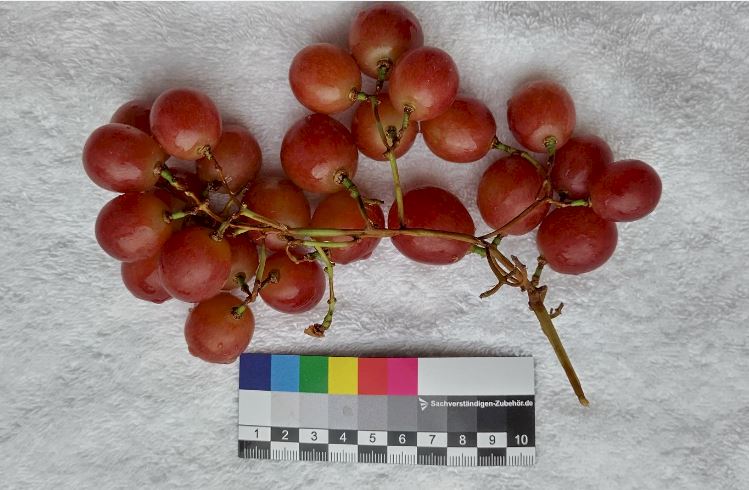
‘Itum 15’ I kind of like this name, as per ‘Item’, but hey it’s a trade name; what about the other 14 items? The photograph makes this grape look very nice indeed, and it is. The red seedless grape is well proportioned too, almost spherical, with varying pink complexions with a lighter base. The skin is so immaterial that it has to be thought about to be reviewed, and it is simply a gateway to the perfectly flavoured juicy interior. I am much inclined to pop the lot. This grape is one of the best I have reviewed. Origin: Spain by Jack’s (part of Tesco) and picked up in a UK Post Office shop (July). The Itum is clearly an Item.
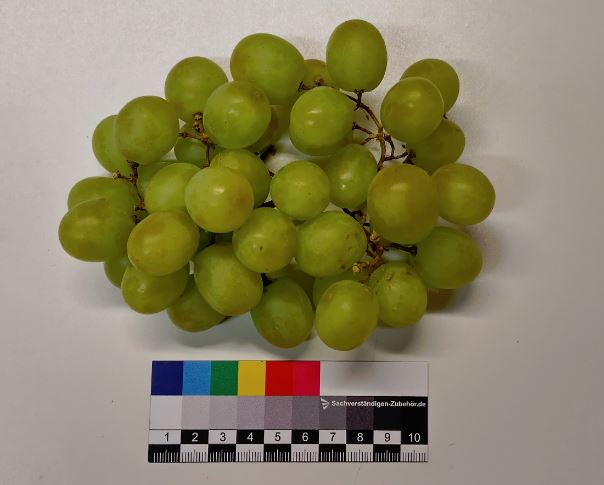
‘Ivory’ – Quite a bright green seedless grape where the flesh is like a puree and lacks all substance. What has happened to this sample, even though it has green stems. Possibly been frozen. Origin: Peru for Tesco.
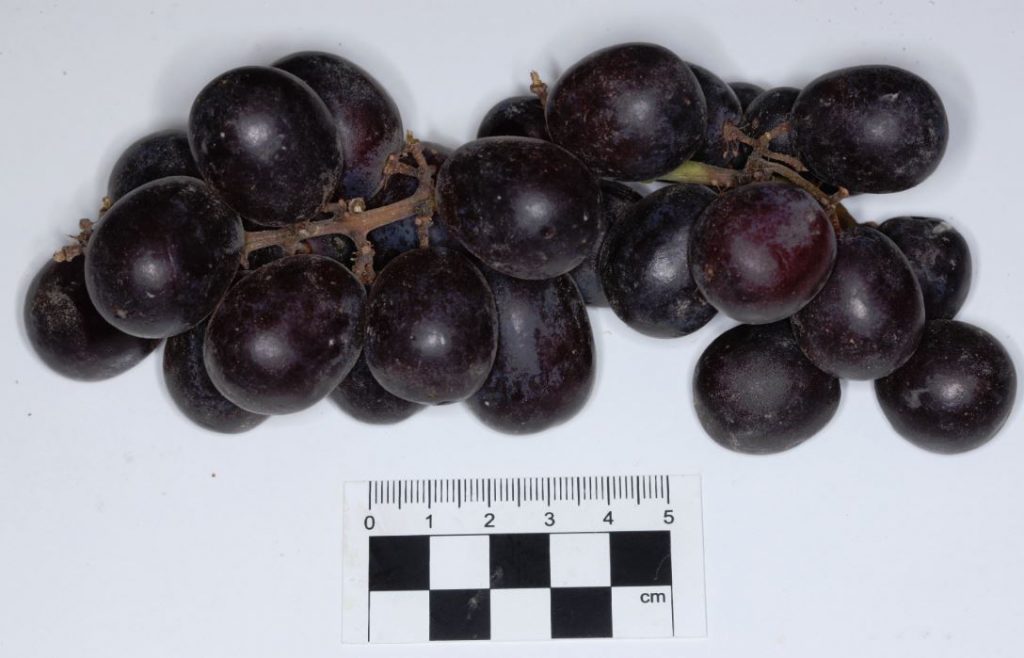
‘Jack’s Salute‘ ‘PLU 3496’ a red seedless grape, but this variety is a bold black. It is a large grape, very slightly elongated, flesh very juicy, skin tough. Source: Peru for Staverton’s Nursery. East Sussex.
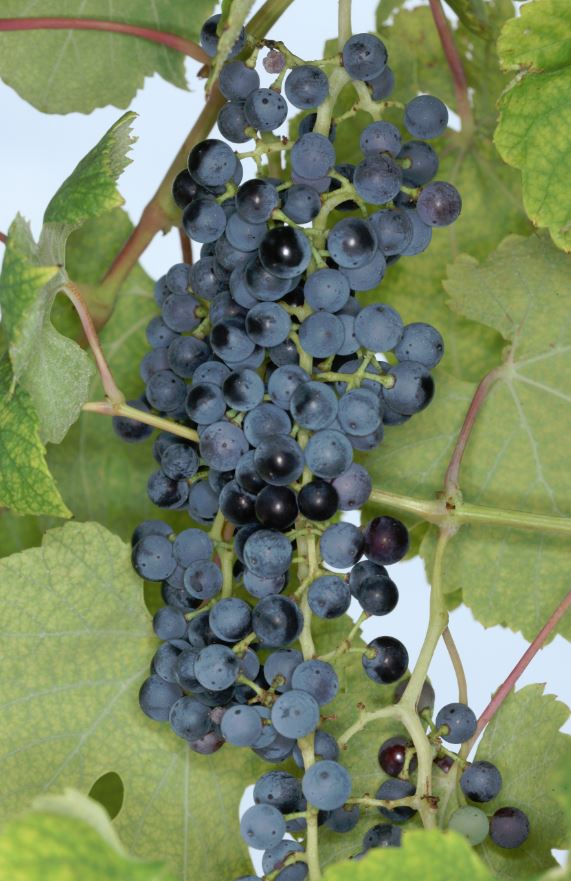
‘Jacques’ – an American selection, a natural hybrid between V. aestivalis and cinerea x vinifera, Growing at St Jean du Gard, France.
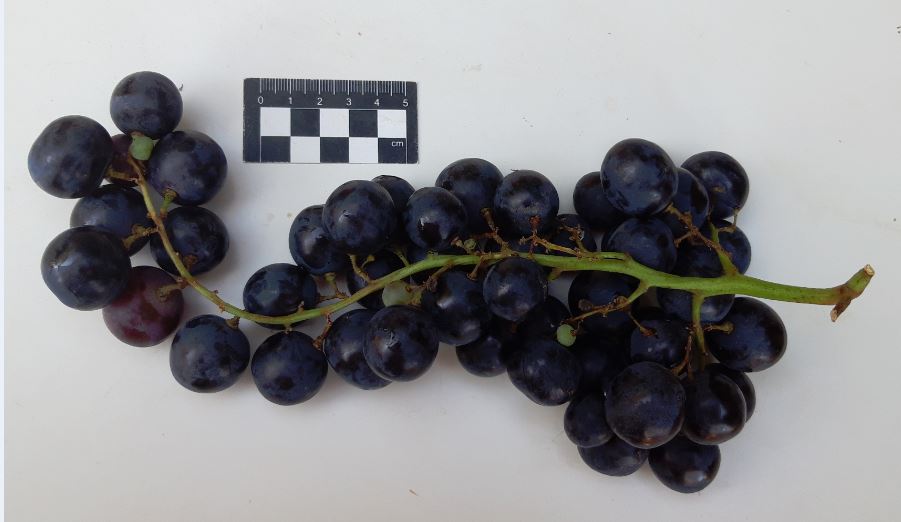
‘La Vallee’ – In perfect freshness, with green stems, this French origin grape sold by Intermarchee, is a large seedless grape looks better than it tastes. The taste is not remarkable, fleshy but not sweet, the skin is tough and slightly bitter. As a table grape, no need to have second helpings. It is a large grape so you only need four.
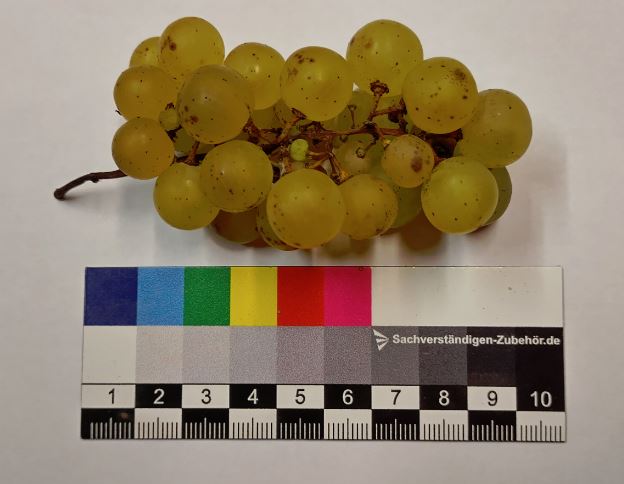
Madeleine Angevine’ or colloquially ‘Mad Angie’ This is a small white grape with pips. It never seems to ripen into large grapes in Southern England. The skin is a little tough, the flesh juicy. With irrigation it might be possible to get larger fruits, and the experience in eating them may be more pleasurable. It is said to be a hybrid from 1857 grown especially for cooler climates, and now widely grown in NW Europe and North America. Origin: Garden in East Sussex, UK.
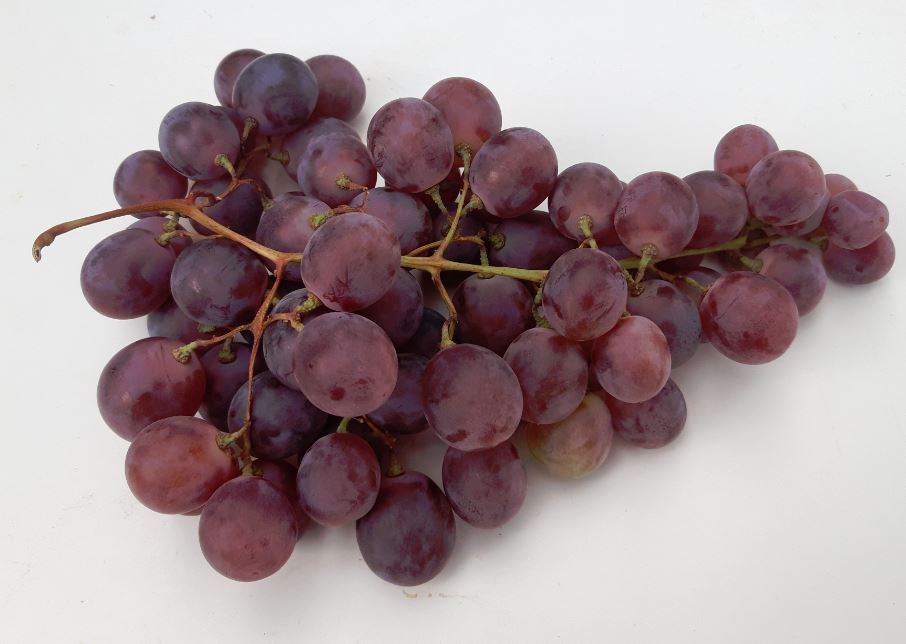
‘Mazzarrone’ – A round pink grape that was not a pleasurable experience, verging on tart, juicy but not sweet and skin was hard. Maybe just a bad lot. Hang it up for a year and make raisins. Origin: Leader Price, France (34)
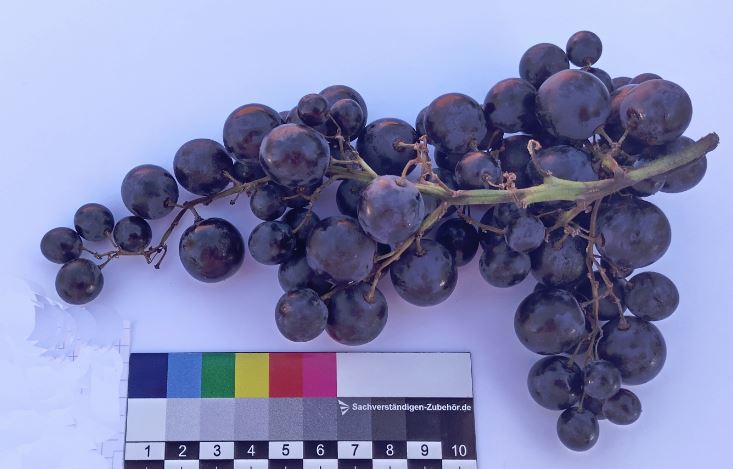
Midnight – A small black grape with small pips. Not a great bunch for reviewing, a little old even though green stems. Grapes are a little fruity with loss of juiciness, skin a little arduous with a small amount of acid setting in. Not a special grape. Origin; Spain via a French supermarket Intermarche. Suprisingly poor bunch having only travelled from Spain to France where reviewed.
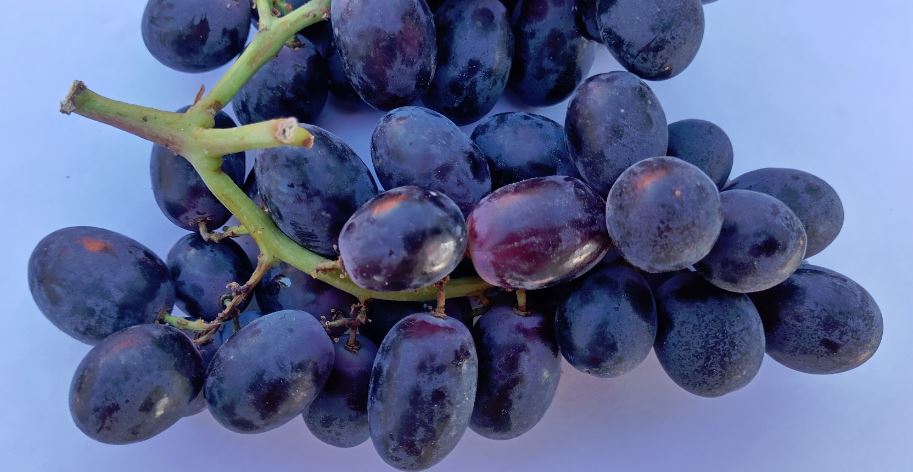
Midnight Beauty (Sugra 13) = A black seedless grape, very likely this season’s grape from Spain, as it has very green stems. The flavour is very watery, warm (the temperature is 34C) without any distinctive quality, just plain, almost bland, but OK and will be appreciated by almost all palates. The skin is not obtrusive, and the overall experience is fine, with watery notes. 7/10. Unlikely to offend anyone. The packet says ‘100% natural’. This lot was fresh but starting to go off in August 2023. Origin: Spain for Intermarche. France (34).
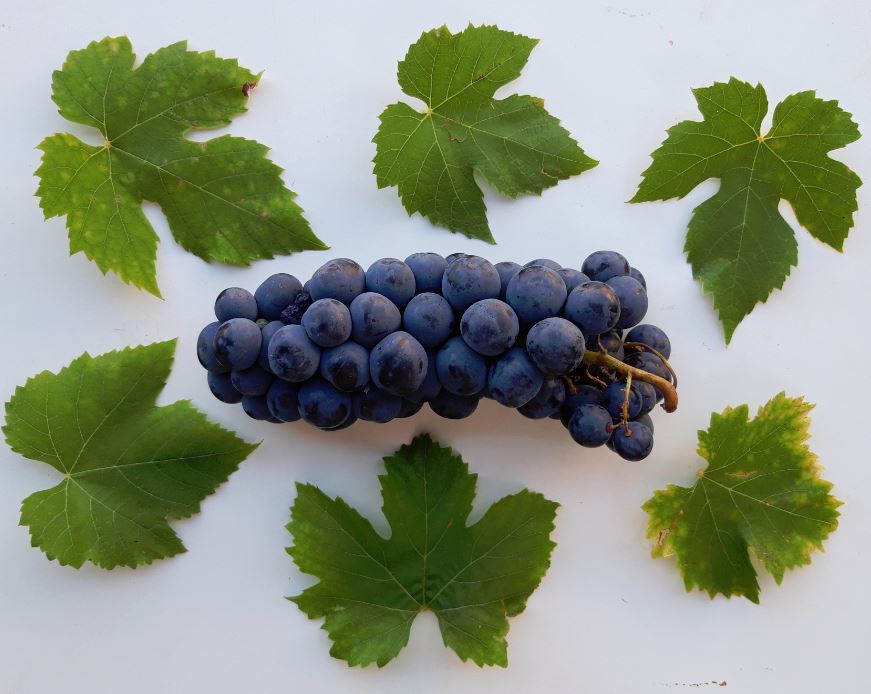
MUSCATS MUSCATS MUSCATS
This section is on the sublime quality of the muscat grape. Not all muscat grapes are this typical colour, however, but the taste is always adorable.

‘MUSCAT Beauty (c) A seedless muscat grape with green stems (which shows it is very fresh). This variety is sometimes referred to as ‘Rosada’, it is basically a white grape that has a rose-light green colour. It is packed with juiciness and the skin is not arduous. Having grown up with the taste of dark purple muscat grapes in Southern France, the colour of this variety came as a big surprise. but tasty. Source: M&S from Chile.
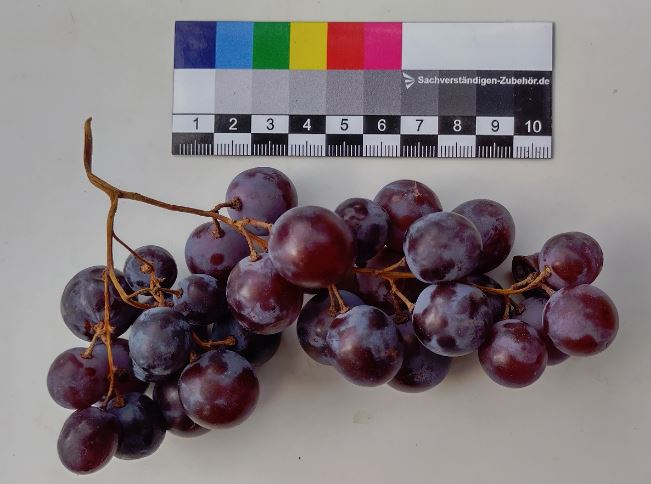
‘MUSCAT Bio’ – as sold in a French Market (Fr, 34), clouded with mould, but indistinquishable from ordinary muscat grapes, taste similar. Seeds small and poppable.
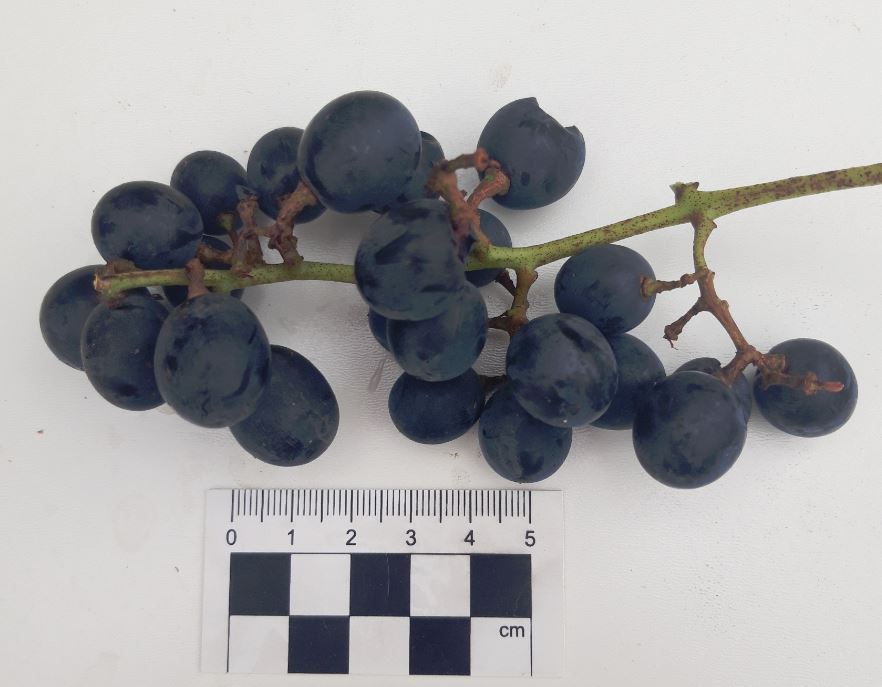
‘MUSCAT Bleu’ Homegrown here in East Sussex, UK, A black grape although it is called bleu, more likely because of its blue covering of mould. It has seeds which reminds one of old times before seedless became more an accepted norm. The grapes are small, rounded, in fairly open bunches. The taste is quite sharp but sweet with large pips and definitely the muscat taste running through. The skin is not too hard. Not quite as tasty as New York Muscat.
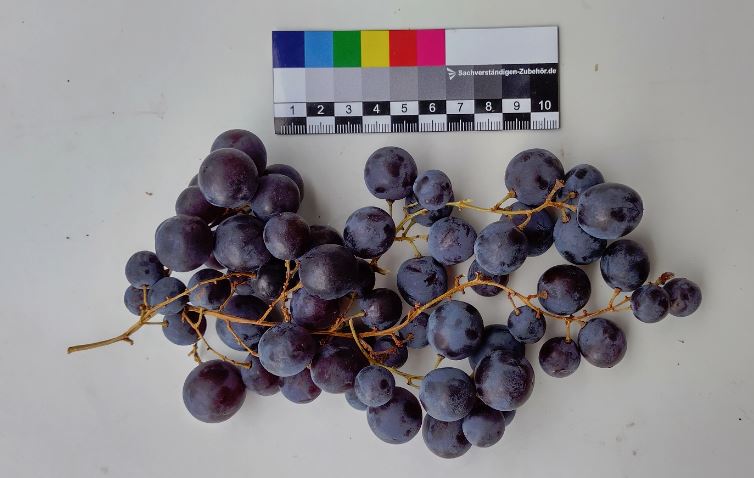
‘MUSCAT de Hambourg’ With pips, but who cares when enjoying a muscat grape. Takes one back to how things used to be casually eating grapes off the vine in the vineyard. Fantastic flavours. Flesh a wicked dose of extra sweet, juicy explosion. I could pop these all day long. The skin is part of the experience and is not an inconvenience in the enjoyment of this grape. Origin: France for Aldi, France (34).
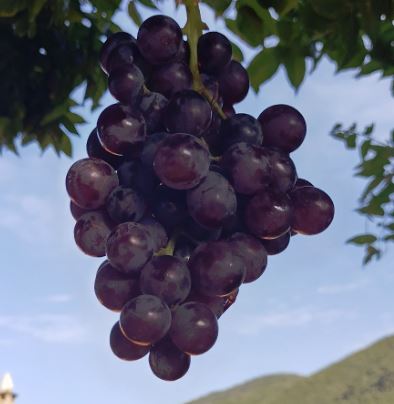
MUSCAT de Hambourg
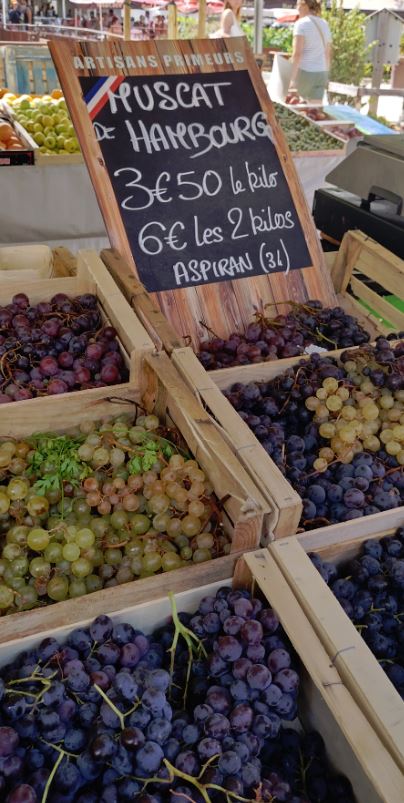
MUSCAT de Hambourg- 2023
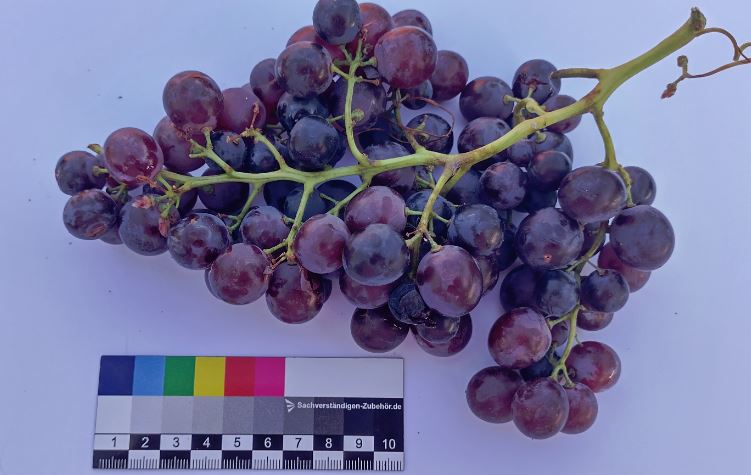
MUSCAT de Herault – These are off a market stall in Ganges (Fr 34), a black seeded grape almost perfectly round. It has all the attributions of a muscat grape, even crunchable pips, dynamic flavour, compact, rounded, not too small or too large, with a noticeable skin which explodes with a mouthful of summer sunshine, all packed in a small convenient package. Origin: Local France.
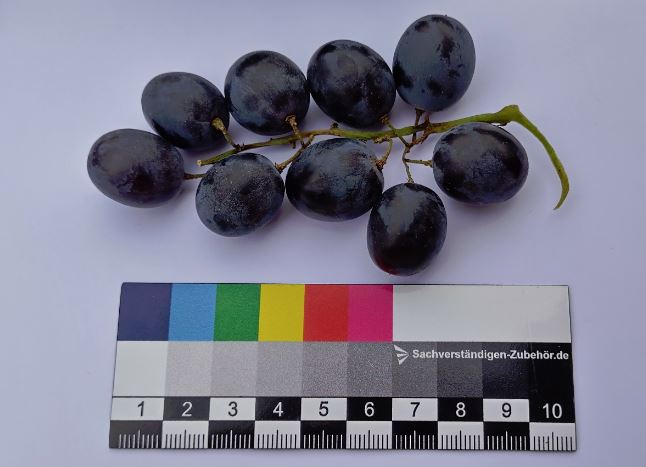
MUSCAT de VENTOUX – One of the few muscat grapes that has a sought after AOP designation. This is a regular sized black grape with tiny pips. Let the publicity blurb do the talking – ‘haut qualite, sa color bleue noir, un delicate pruine texture, onchueuse gout sucre et unique. That just about covers all the suitable adjectives. The box carries a high value logo including a butterfly, which presumably means it is grown in some sympathetic way with nature. These grapes are grown in a ‘micro-region between Mt Ventoux and Avignon.’ I have seen the vineyards on the slopes of Mt Ventoux and I would agree it has all the particular terroire of sun and soil. Origin: France, Ventoux, sold in Intermarche supermarket.
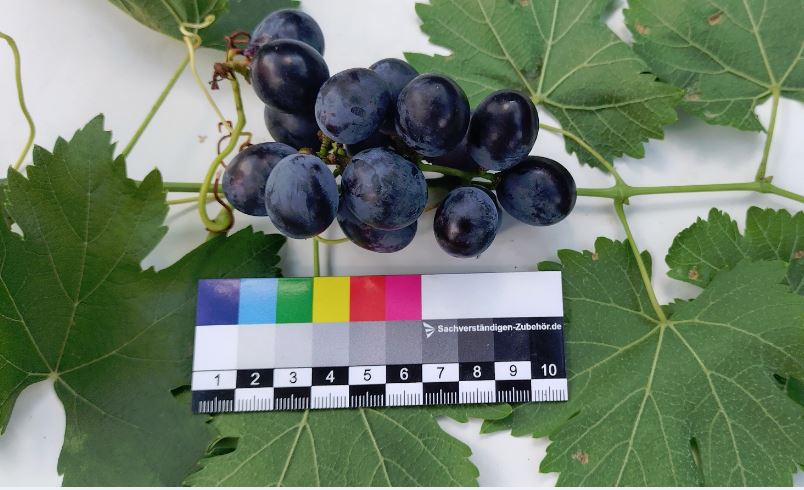
MUSCAT ‘Oeillade’ This variety has larger leaves than the normal Vitis ‘Oeillade’ and it has fairly similar flavour, perhaps sweeter. It is still a large black muscat grape with pips and with all the flavour you would expect from any muscat. It is deserving of the top table. Origin: Cevennes. Fr (30)
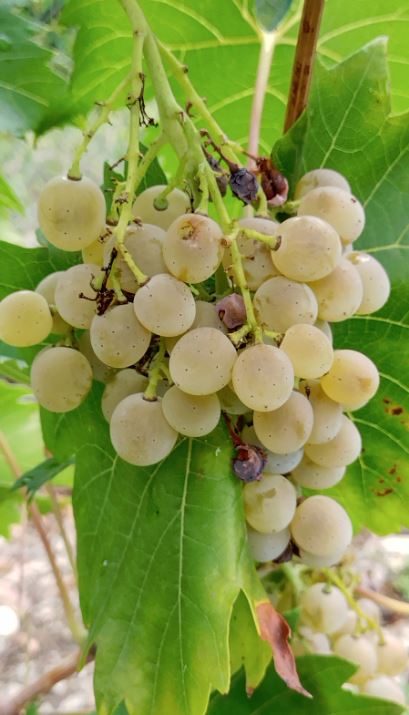
‘MUSCAT’ White – If you thought that all muscat grapes are black you would be wrong. The white one is just as tasty and juicy and full of sunshine and sheer pleasure that all muscats bring. Origin: Cevennes. Fr (30)
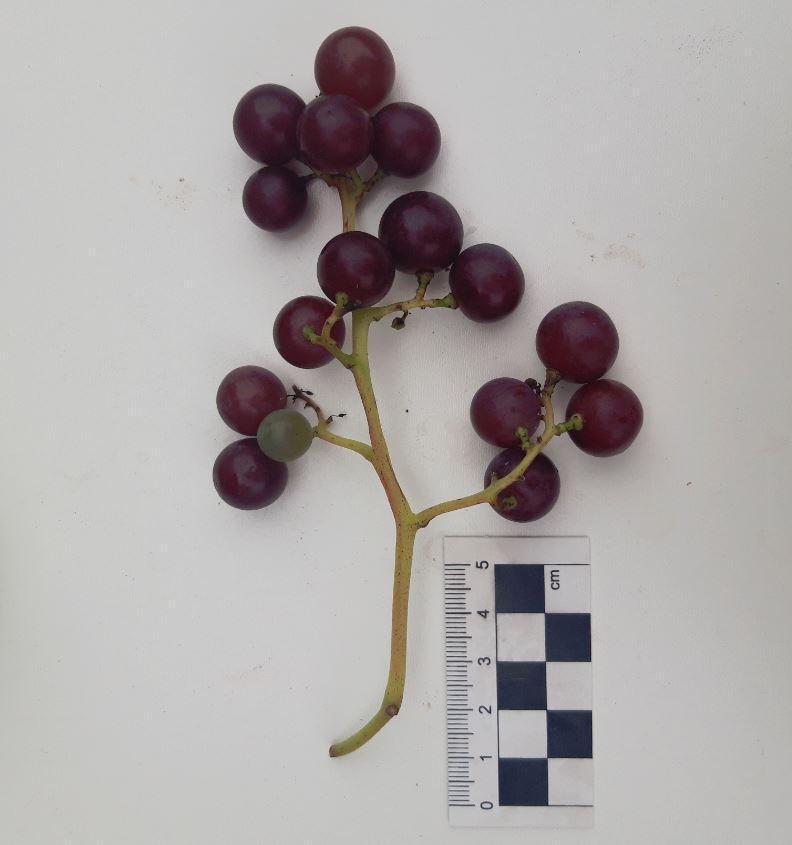
‘New York MUSCAT‘ Home grown in East Sussex, A red grape which ripens to a darker hue. The flesh pops out of the skin like a sac of juiciness. It has pips which are rather large for a grape. Skin is thin. It is a bright and cheerful grape full of sweet surprises. One of the best muscat grapes – definitely like this grape.
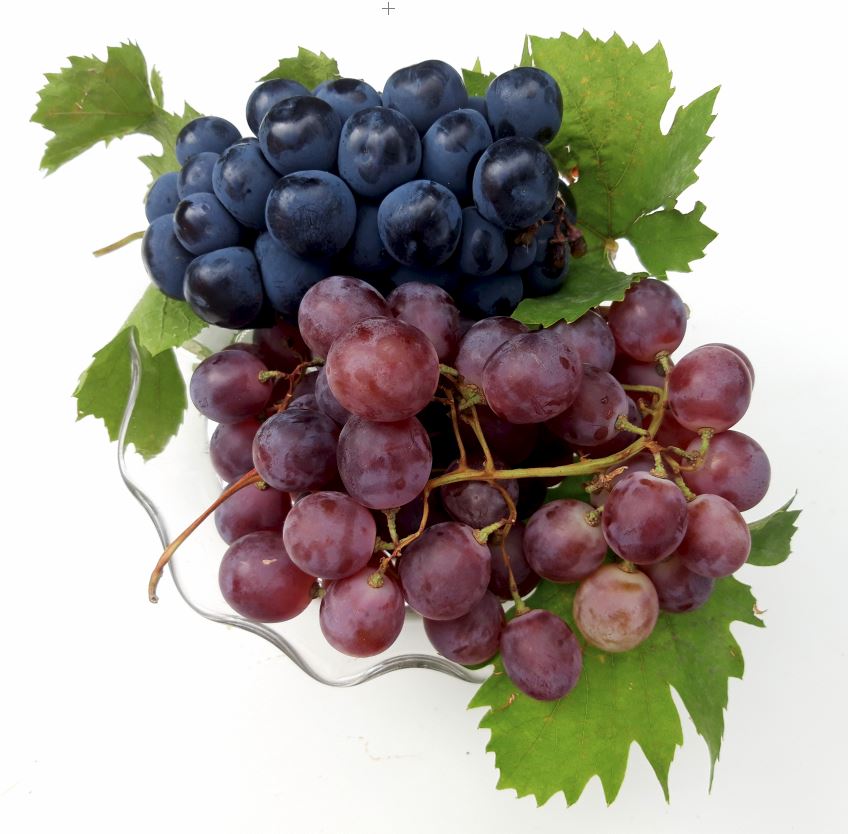
End of MUSCAT display. Shown here are Muscats and Mazzarrone grapes on display.
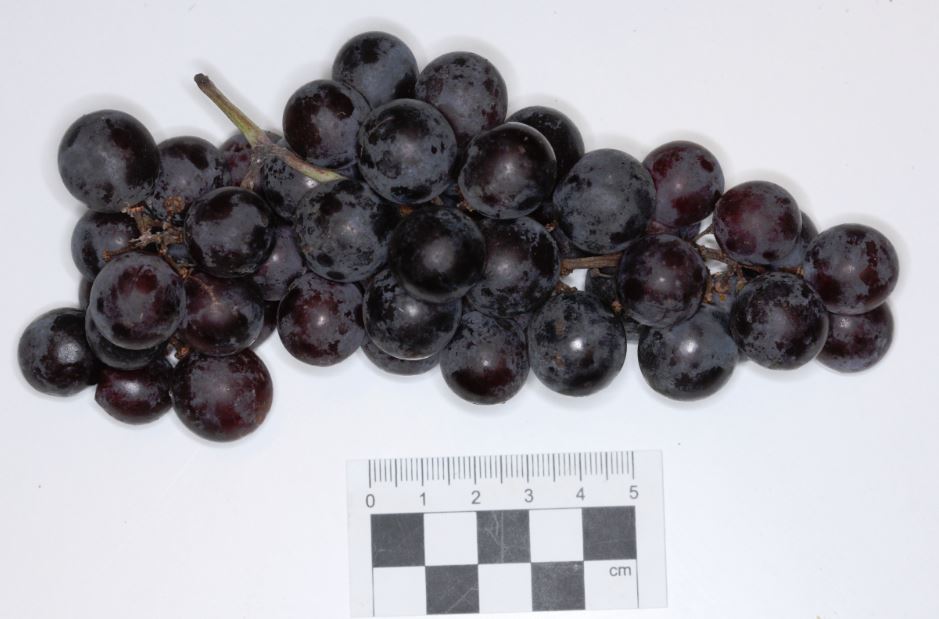
”Natorra’ – A ‘Strawberry Nagolina grape’ A black grape that has a strong smell of strawberries before being taken out of the supermarket box, and afterwards. Flesh comes out of the skin as a sac in the mouth, like frogs’ spawn, leaving a tough skin to chew over. There are pips to discard. Clearly an acquired taste and experience, up there with Vitoria, some may hate. Source: Ocado with M&S by appointment.
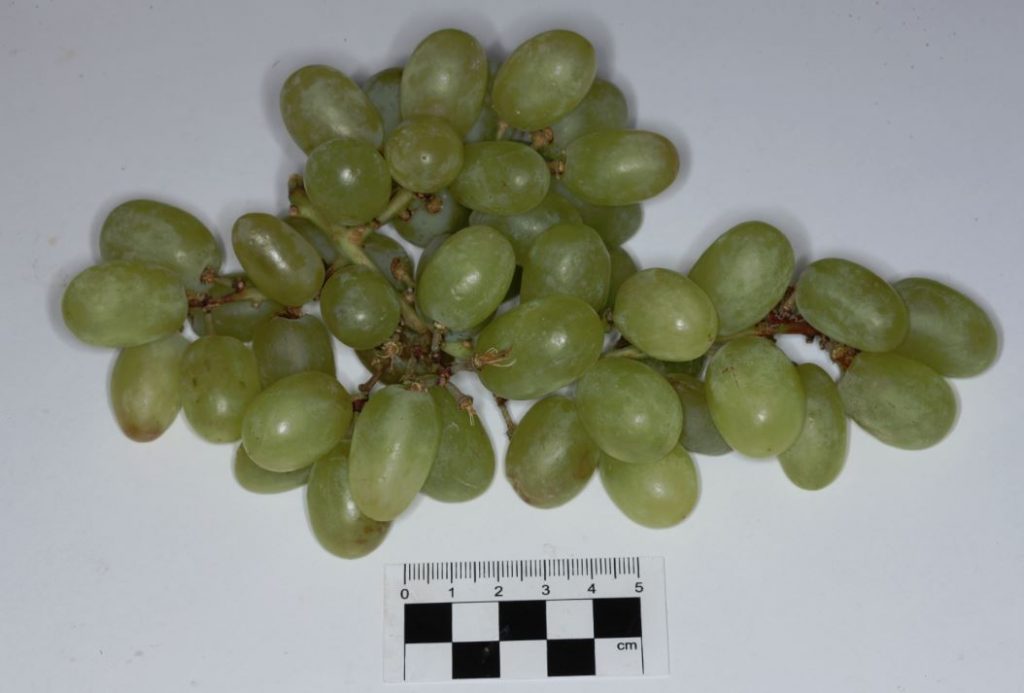
‘Orchidea’ a white seedless grape, slightly elongated, flesh ordinary with a flash of sweetness. Skin not too thick. Source: Staverton Nursery, likely to be from Cabernet Sauvignon, marketed by ‘Les Declicias’
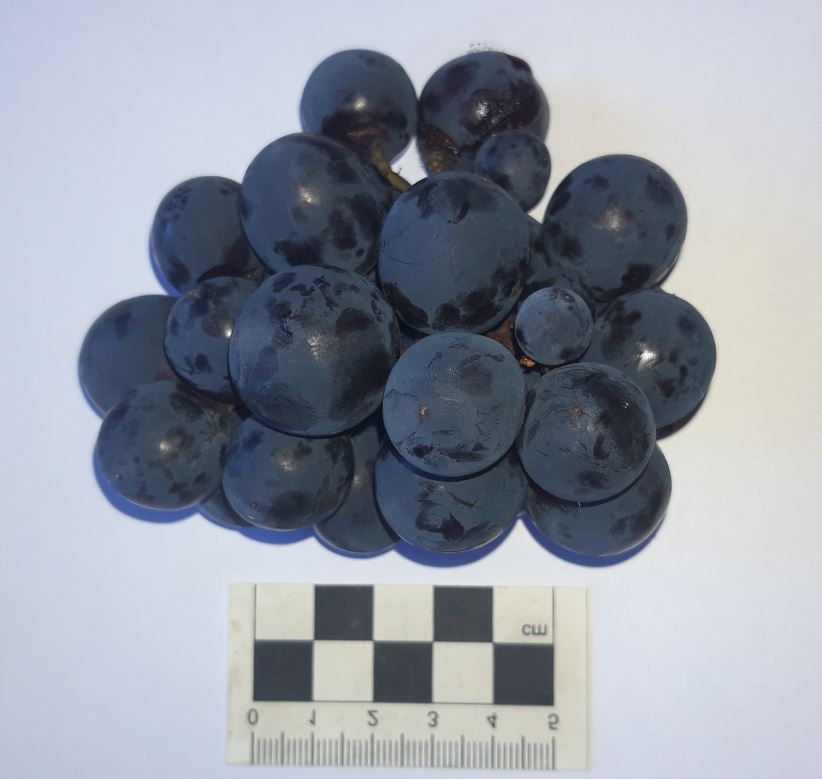
‘Prima’ – A very pleasant,black, juicy grape which, when eaten the contents pops out of the skin as a package of sweetness. The skin is a little chewy. Although the origin of the grapes is France (sold by Aldi) the stems were dark and not fresh green.
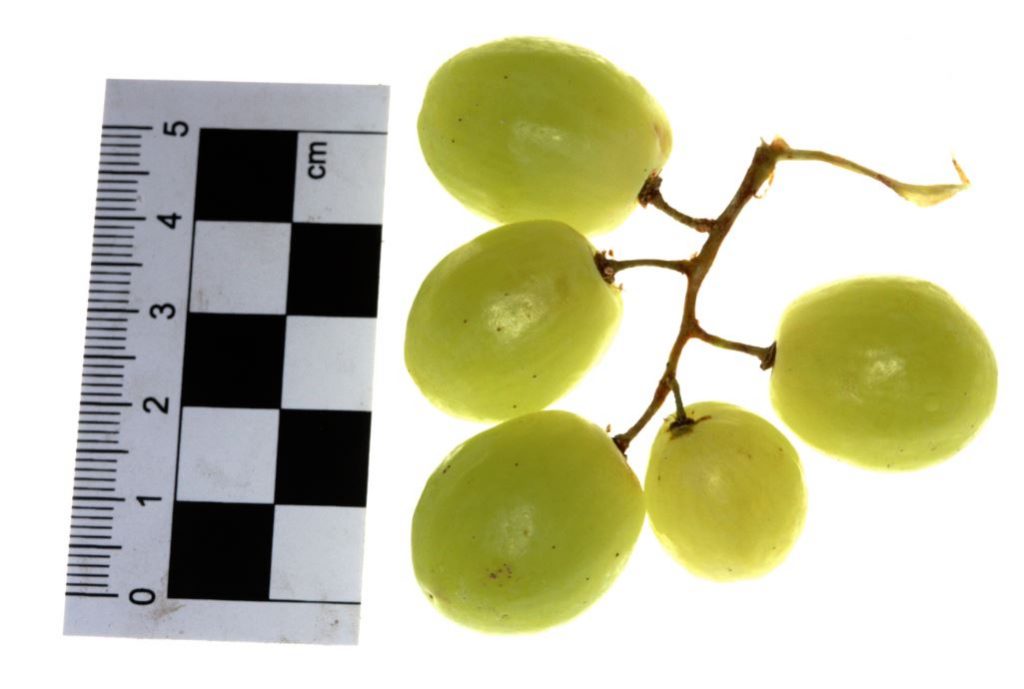
‘Prime’ – A white seedless grape which is just what it says on the label ‘sweet and juicy’ (unusual for such claims in grapes), hints of high summer, fruits, skin not too tough, aftertaste good. Origin: Egypt for Ocado, other suppliers source from Namibia.
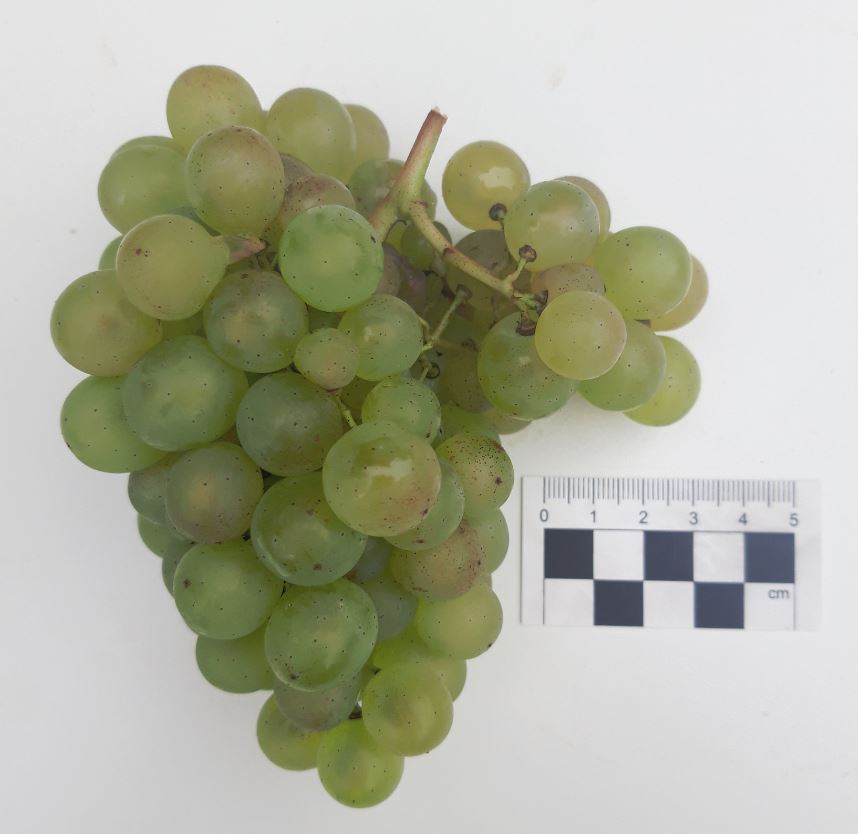
‘Phonix’, also ‘Phoenix‘. Home grown in East Sussex. A very vigorous outdoor white grape. Can reliably produce 60 bunches of grape every year. Very juicy and more watery than sweet. Pips, yes, but not many and small. About 10-20 grapes can be popped successively for a great experience. It is a battle to eat them all before the autumn weather deteriorates. The skin is OK and not intrusive.
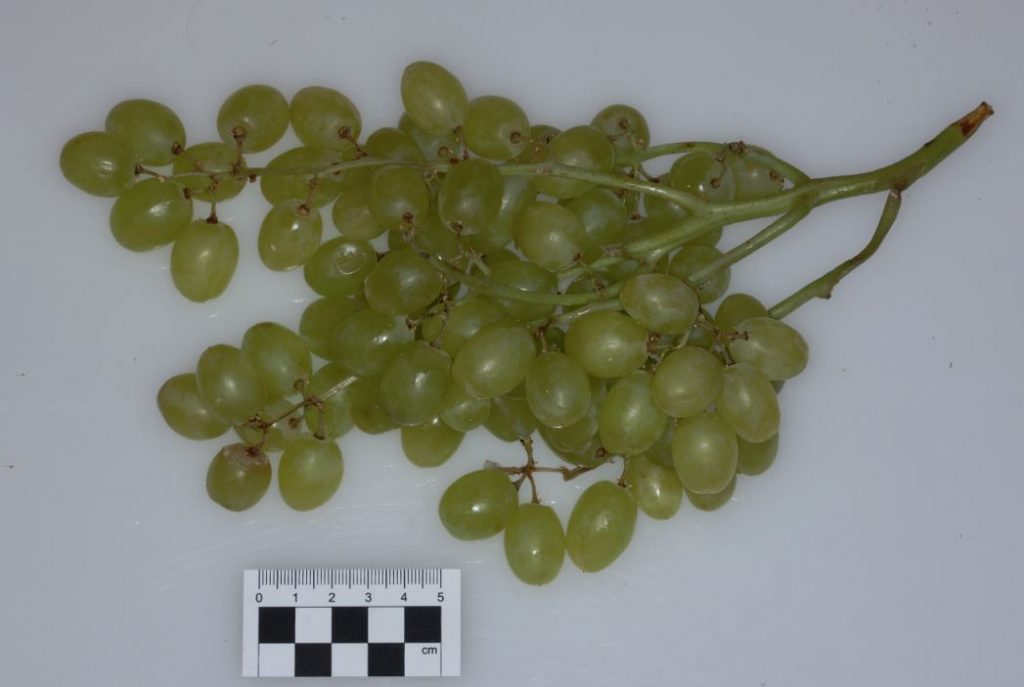
‘Punnet’ – sold as ! – a regular green seedless grape. There is a tendency in the UK and France at least to sell grapes as ‘Green Seedless Grapes’ and ‘Black Seedless Grapes’ without any name.
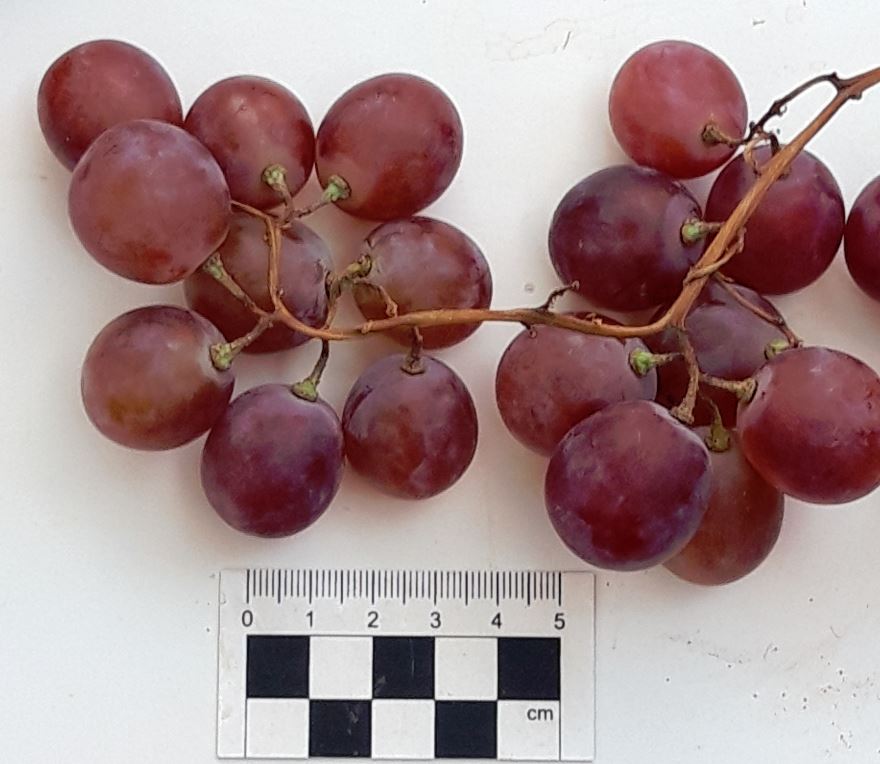
Raisin Rose Vrac‘ also called ‘Charlotte‘ by Cervino Interfruits, ‘Raisin de Sicile.’ A large round grape with pips, from Sicily. The weight of a sample of six grapes was 8.43g each! A larger grape gives a larger area for tasting pleasure, flesh is light, refreshing, juicy, more juicy than sweet, a good experience. Skin not a nuisance but it has pips. It is what it is, an old part of the Mediterranean experience, big enough to squeeze out the pips before eating the large fleshy grape. A good eat. Origin: Italy for Intermarche, France.
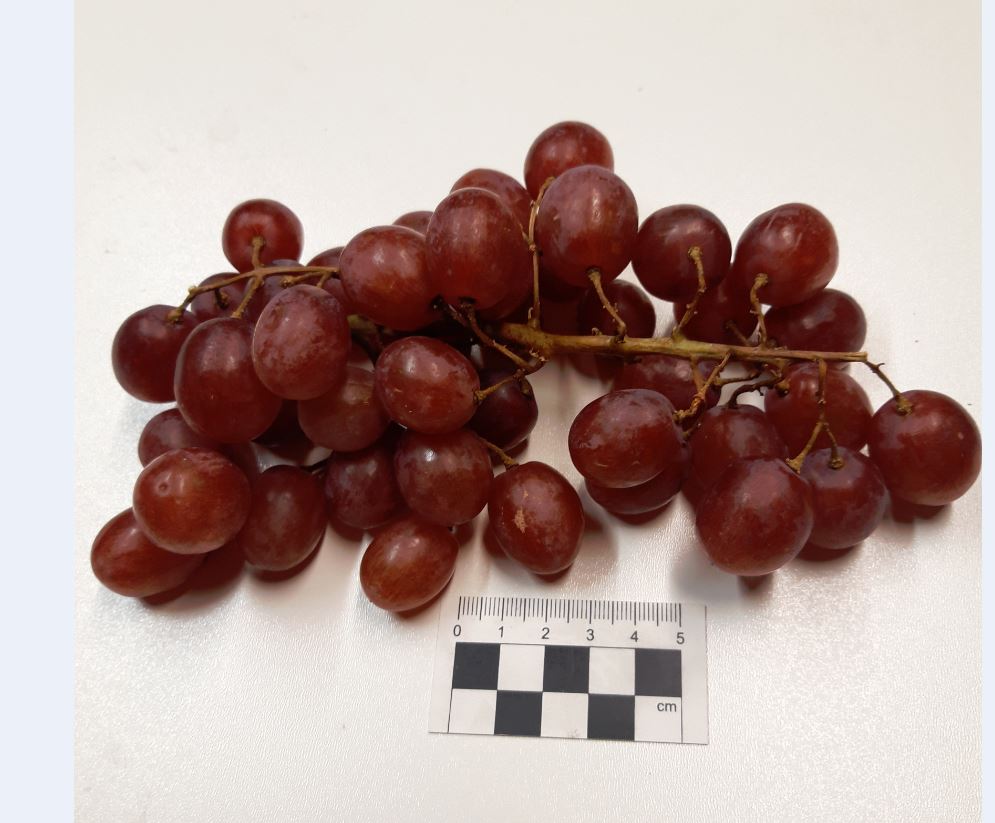
‘Ralli’ – a red pink seedless grape, highly delicious, luscious, pluckable, slightly elongate / ellipsoidal, skin thin, flesh sweet and dissolving into mouthfuls of pleasure. This is certainly a five star grape. More please. Origin: South Africa for Tesco, part of ‘Jacks’
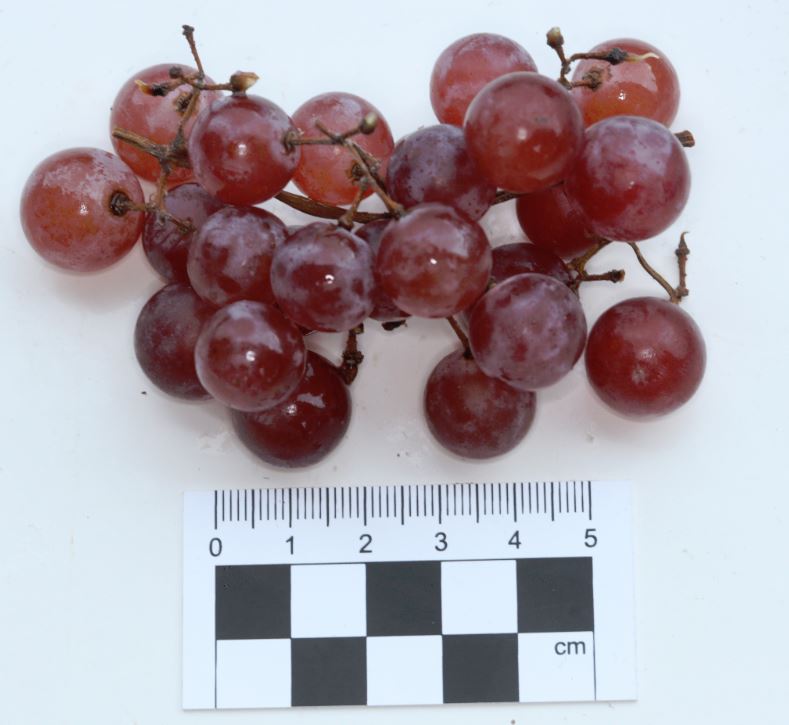
‘Red Clobe‘, a red grape with seeds, low to medium sweetness. Origin: Italy for Leader Price in France.
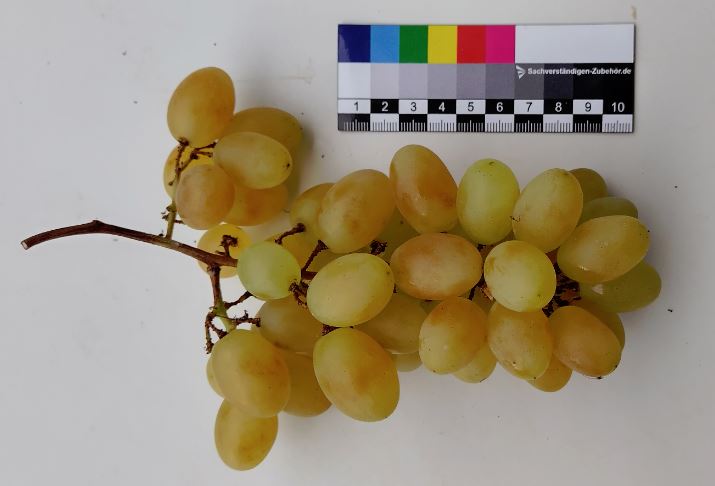
‘Regal’, a white ‘sans pepin’ grape, but typically green going to shades of orange as it gets older, and becoming more flavoursome. The shape is slightly oblong. It is good, fleshy and juicy, but skin is tough, unpleasant and bitter when chewed extensively. This is not a grape to have at the bedside as restorative food. It is a table grape that is bettered by newer varieties. Origin: Italy from a French supermarket.
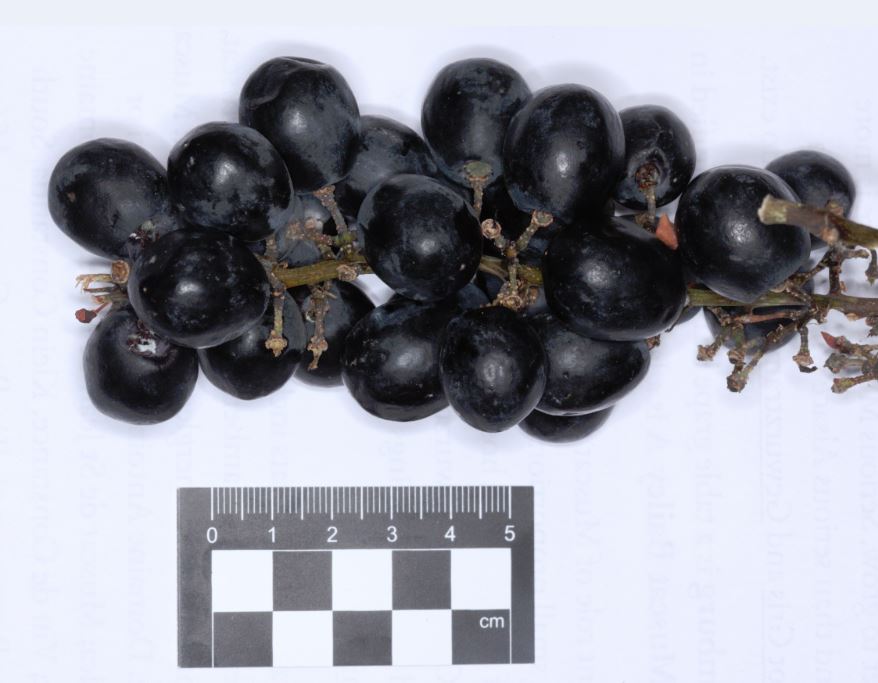
‘Sable‘ a seedless black variety which is, according to the packet ‘intensely sweet and aromatic’. Origin: Brazil for Waitrose (Nov) and Brazil for M&S (July), or South Africa via Aldi (Fr, 34) in March. Otherwise called ‘Sugrasixteen‘ by Aldi, a ‘raisin noir, sans pepin’, it is regular-sized grape with sharp skin enclosing a dense but firm and juicy flesh, not overly sweet, with an agreeable disappearing bolus. No aftertaste, 9/10 for pleasantness.
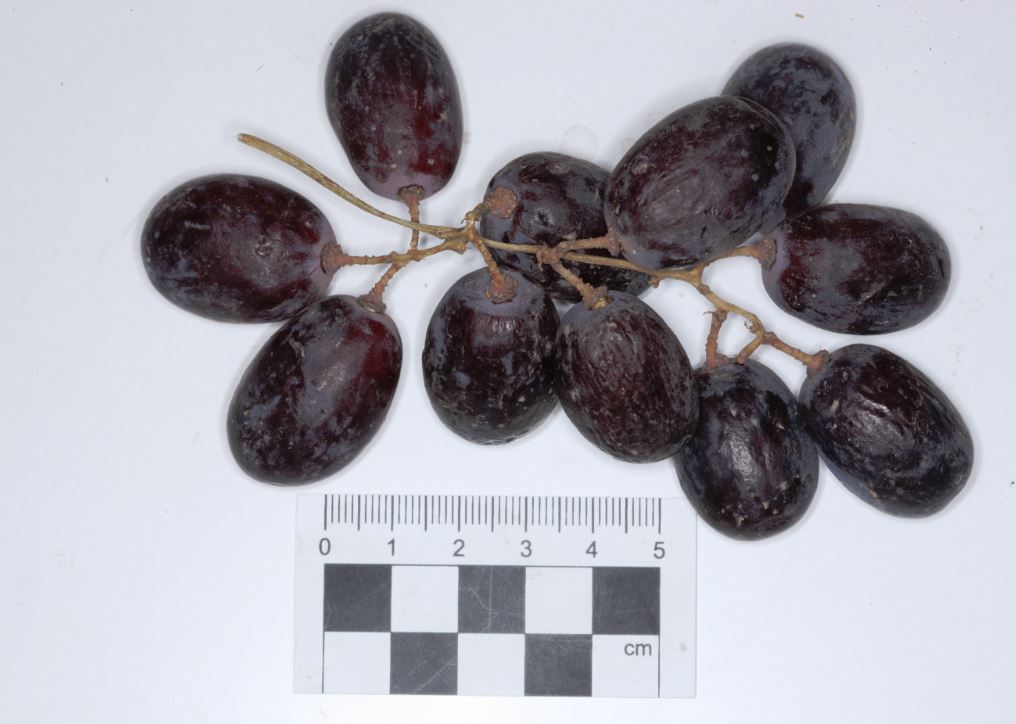
‘Scarlotta’ – with a name indicating red, this is a black grape, slightly oblong with fairly tight skin and the flesh good but not outstanding. The skin is chewy. This sample was covered in fungal spores.
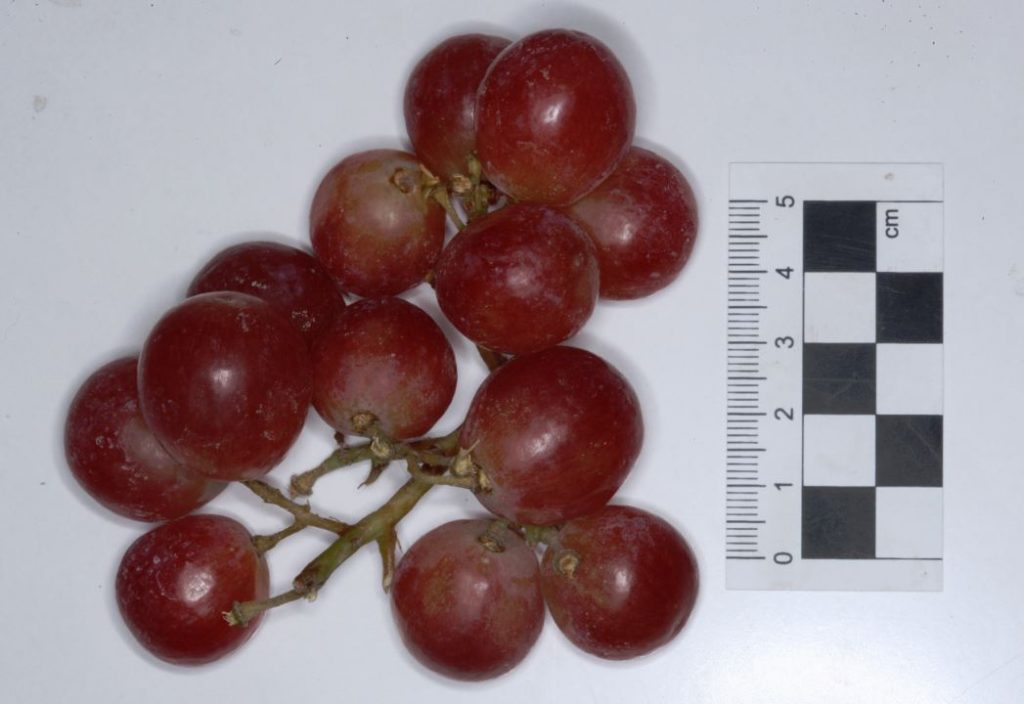
‘Starlight’ – is a seedless, round red (sometimes pink) grape with very agreeable taste. The flesh is sweet with no aftertaste.A mutation of ‘Prime’. Origin: Egypt for Ocado, UK.
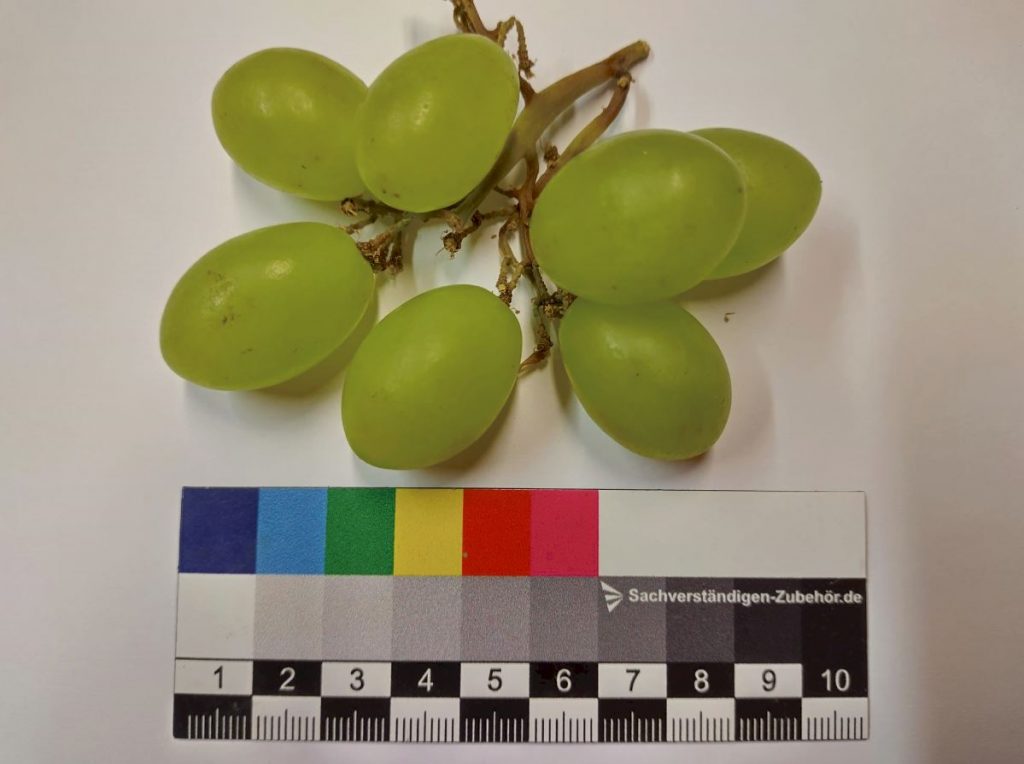
‘Sugar Crisp‘ – Sold as a seedless white grape’ it is actually a green grape that is slightly elongate and makes for a fine experience. The taste is excellent, the flesh unremarkable (which is good), the skin thin and not laborious to eat, and there is no aftertaste. An all round good grape, especially for popping. This bunch was reasonably fresh but it has come a long way from Bahia state in North-east Brazil. Origin: Brazil for Sainsburys.
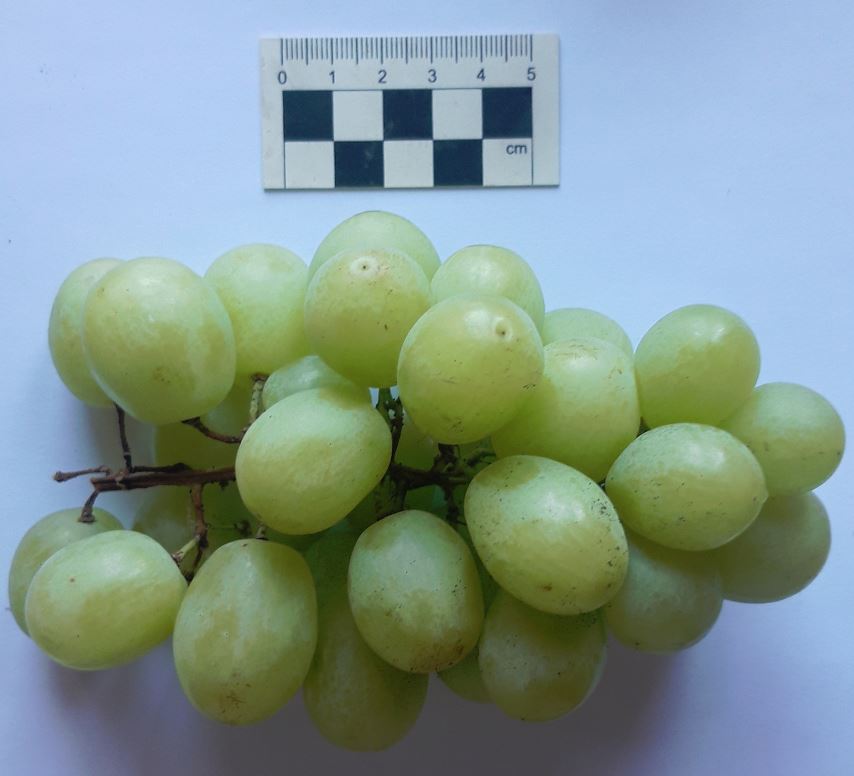
‘Sugarone’ – A very very large seedless grape, named ‘Uva Senza Semi’ on the packet, but it is a variety called Sugarone. The origin is from Palagonia (Italy) sold by Aldi in France (34). The grape is hard work to review, and eat. It is very bland, not pleasant, flesh just about OK, skin not too hard. Clearly bred for size to impress, but what do you do with 800g of grapes, decoration or put aside to make raisins..?
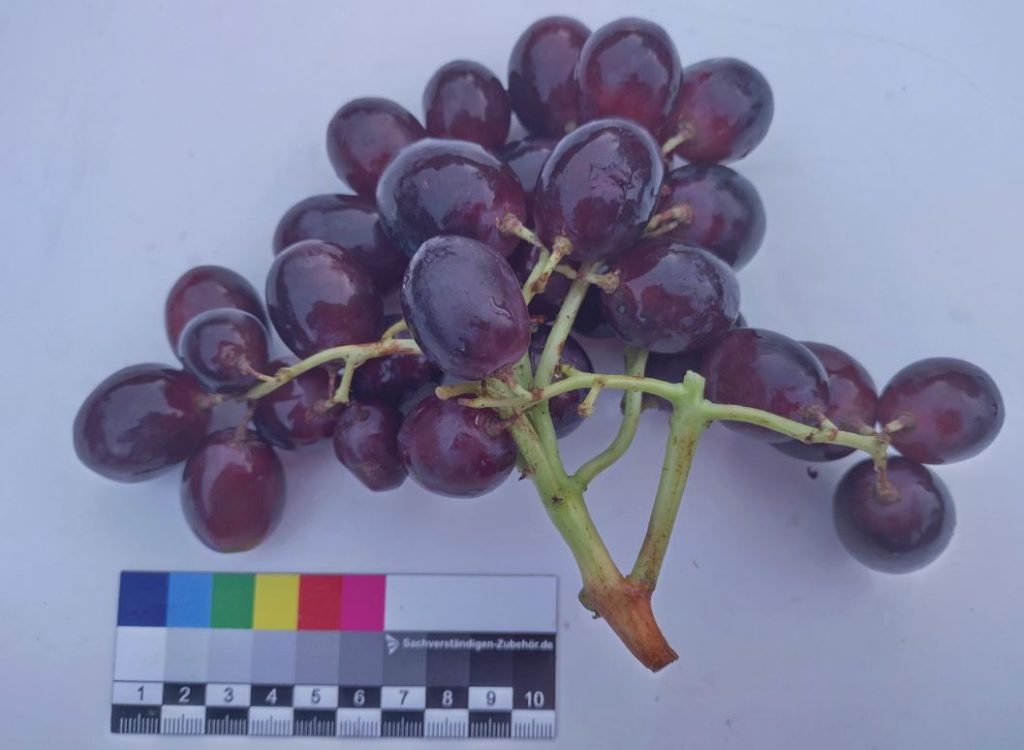
‘Sugra 48’ a large, squashy, rich red seedless grape. This sample was inedible as it was over-mature, with grapes falling off the bunch, fungus growing in clusters and the grapes sweating like mad. The taste was awful. Too old, all taste and flavour lost in flight or by road! A spitoon for grapes is needed. Origin: Spain, Murcia. from a supermarket near Helsinki, Finland.
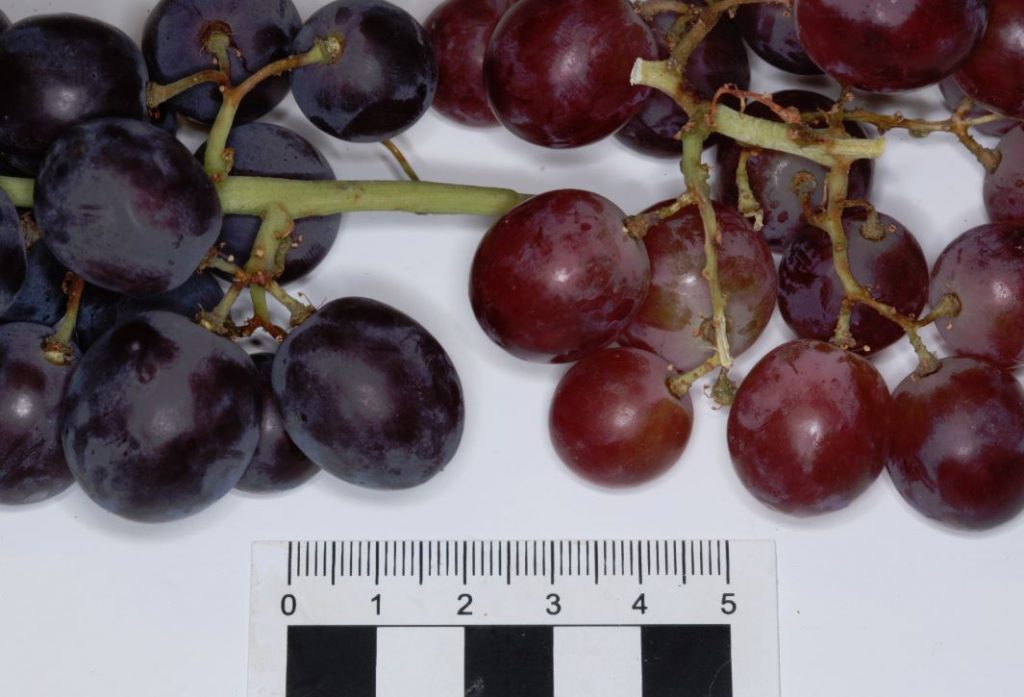
‘Sweet Celebration‘ a red to dark purple, round to oval-shaped grape, seedless grape. It pops to reveal a mouthful of delicious juicy flesh, skin a little tough but not a distraction. It seems to age well, keeping the juiciness inside for a few weeks. Origin: Namibia for Ocado.
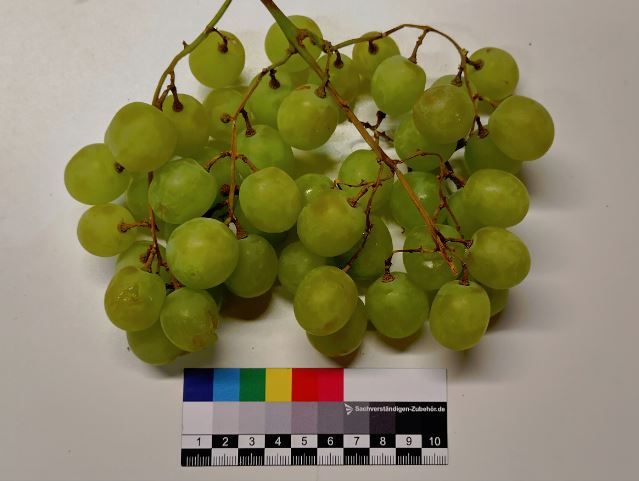
‘Sweet Globe’ – a green seedless grape. erring on the bland tasteless variety with all succulence bred out overshadowed by a thick skin that is difficult to chew and masks everything. The experience is hard going and this grape may best sit best as an ornament on the table. These grapes appear to be old (brown stems) and the flesh is mushy – possibly experienced frost in storage. Another batch, another year were fine, still hard. Origin: Namibia for Coop and Ocado.
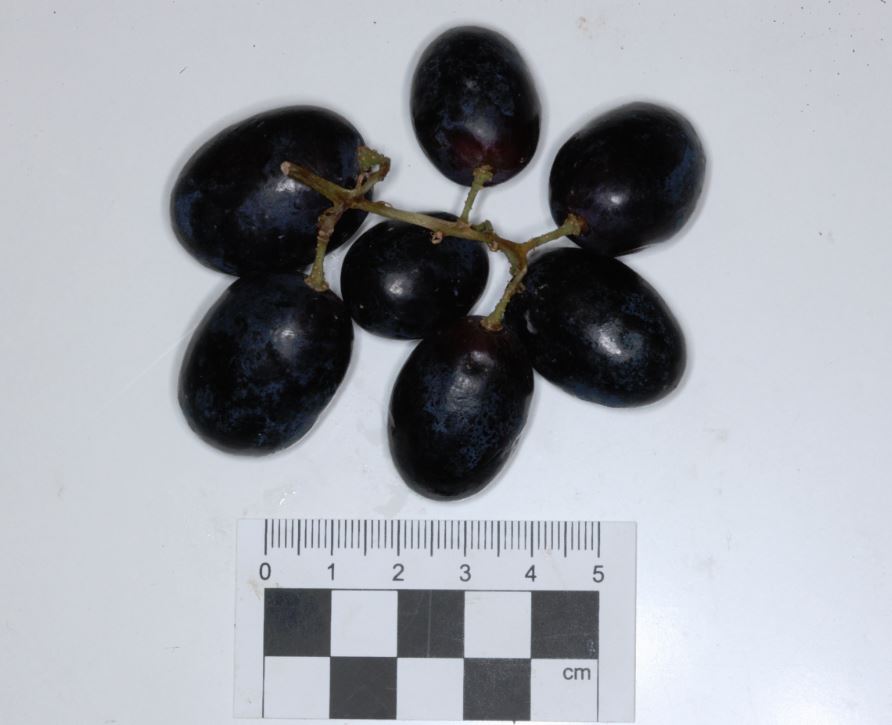
‘Sweet Joy‘ – a plain simple black grape, slightly elipsoid with firm flesh, hard skin with a slightly bitter aftertaste.
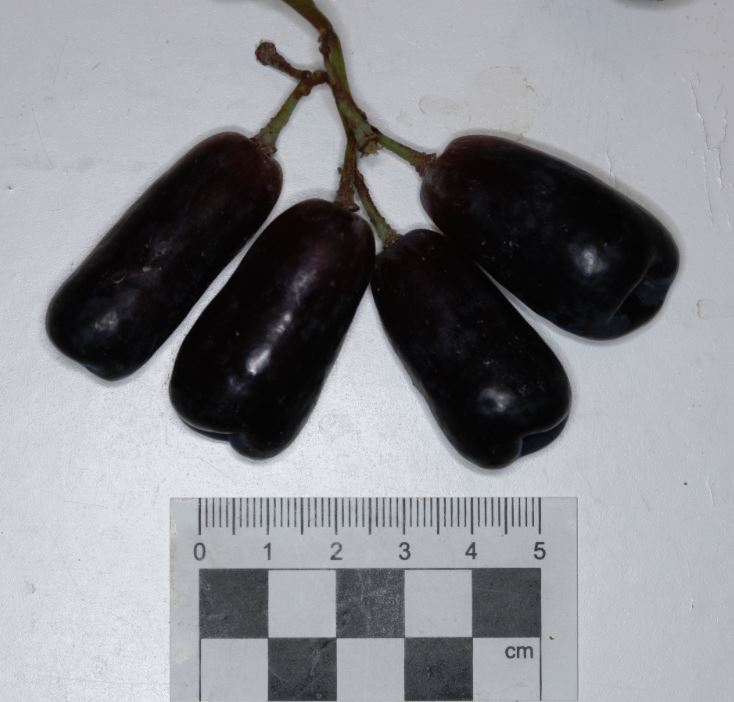
‘Sweet Sapphire‘ an odd-ball black grape with an unusual shape. Stiff and not too grapey.
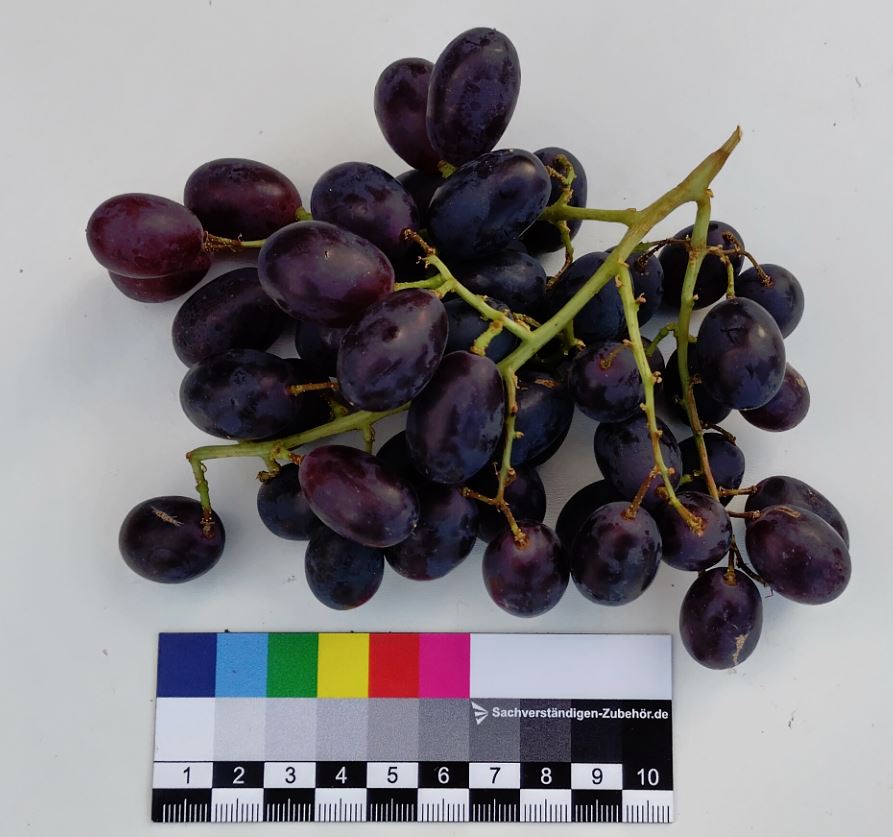
‘Sweet Surrender’ – somehow these South African grapes looked tired and sweaty although they had green stems – always a sign of relative freshness. The taste was definitely sweet, the going juicy and the skin just a little bit on the tough side. Some of these grapes tasted sweeter as though they had benefited from aging (often brings out the flavour). Marketed as black seedless grapes which are ‘sweet and juicy’ to which I agree, but I don’t think I will ;surrender’ to it, like I would a muscat grape. Origin: Namibia via Lidl, Bexhill, Sussex.
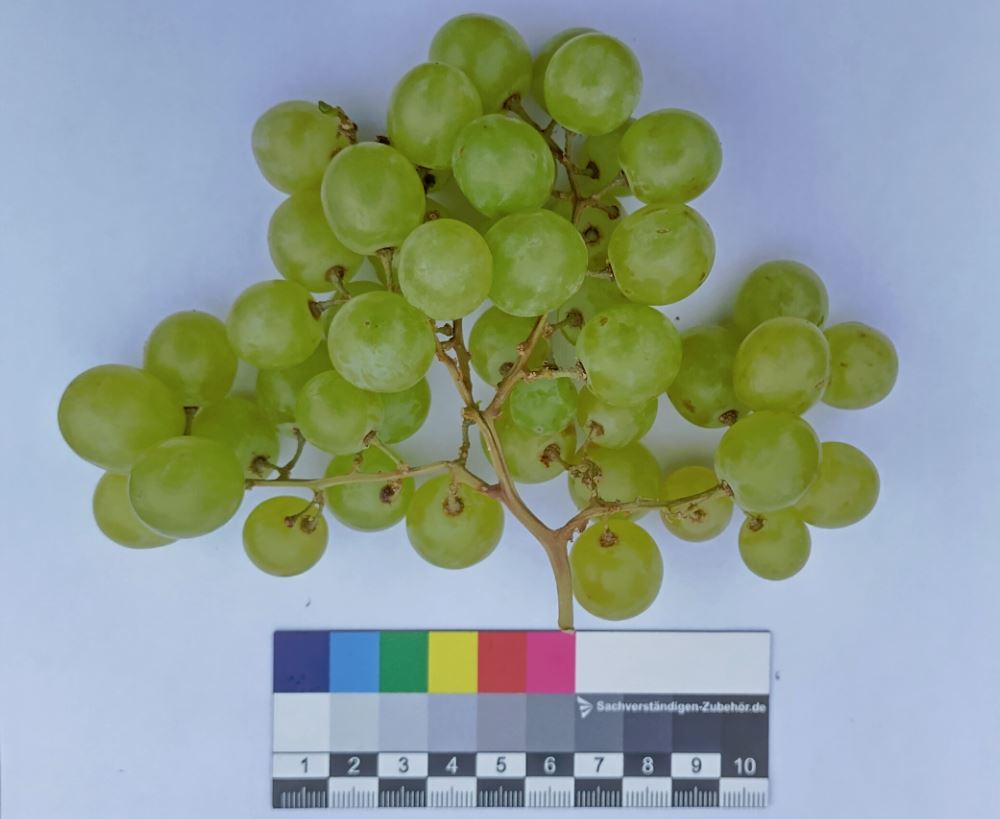
‘Superior Seedless’ – a very popular variety of very small white seedless grapes that are juicy, but not that sweet, a tad tart. The skin is not quite an incumberance. When sold in a pack with another grape (‘Flame’) it definitely came out second in the taste test. In the UK this variety is available from garden centres and in the US hardwood cutting are available to grow at home. There are several tastier varieties to grow whilst waiting for the vines to produce in quantity. Origin: Egypt for Jempsons.
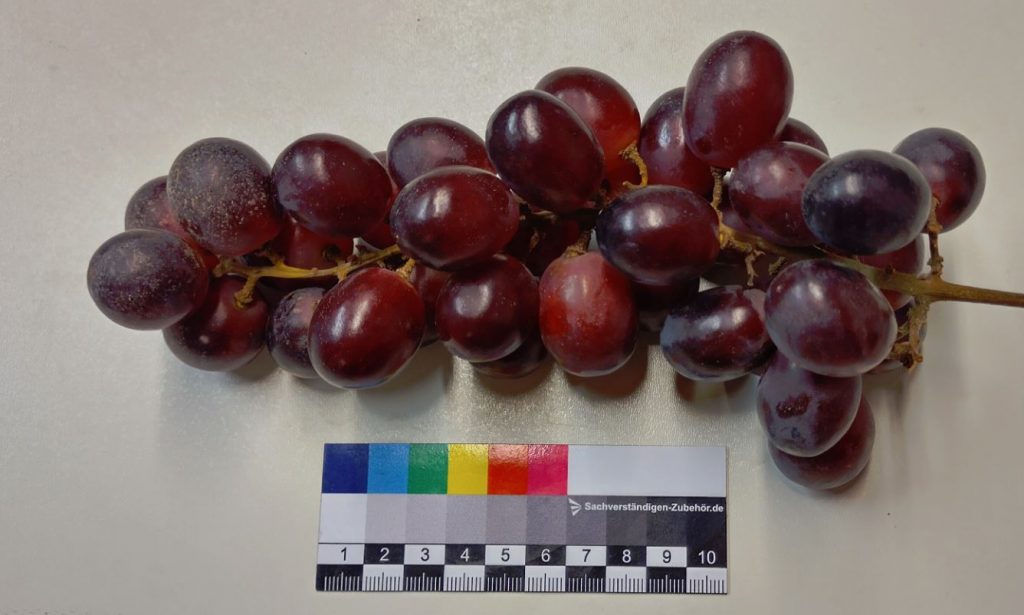
‘Tawny‘ – an almost indistinguishable-looking seedless grape as ‘IFG-Three’ marketed by the same company, from the same continent, but tasting much better, The bunches of slight to dark purple grapes are thickly covered in fungal mould (see the photo), but this does not affect the experience. Origin: Peru via Jack’s and Tesco Ireland, purchased in local post office.
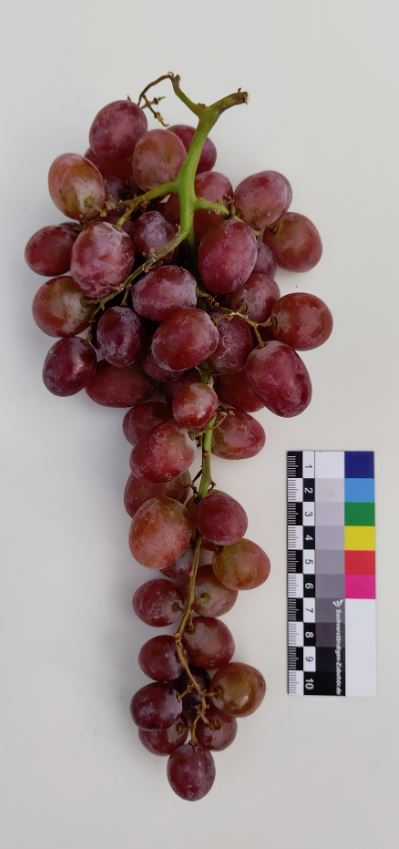
Tutti Frutti, also called IFG Candy Hearts. A red seedless grape marketed as ‘bursting with exotic fruity flavours’ and ‘naturally grown’ whatever that means. Probably organic. The taste and experience hits all the right notes. It is a weird yet wonderful grape. The skin is not an issue as the explosion of exotic notes does take over. I can see that some people might be knocked over by the taste, like drinking a sweet wine by mistake of a dry wine, but most will find this a perfect grape that transcends all those taught, turgid, bouncy grapes of no taste. Maybe the secret of Tutti Frutti is in its genetic mix. Definitely weird and wonderful or a marmite moment too. Source: M&S via Ocado.
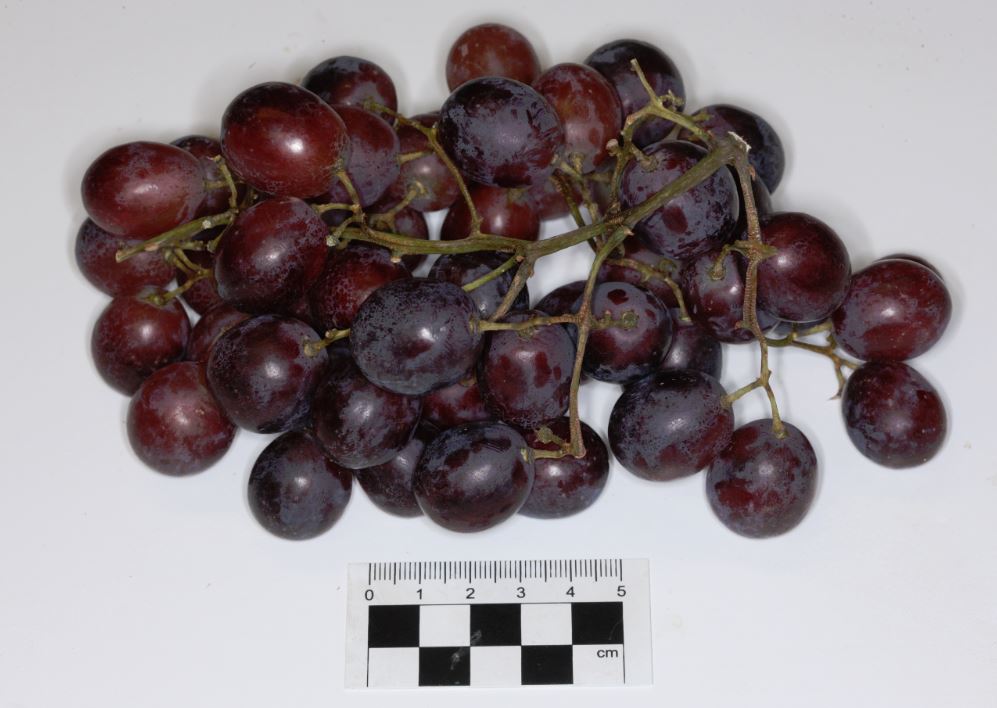
‘Timco’ A seedless red grape, mostly round, slightly variable in colour, skin thin, flesh tasty, juicy, refreshing with bursts of pleasure. Excellent. Origin: South Africa for Ocado.
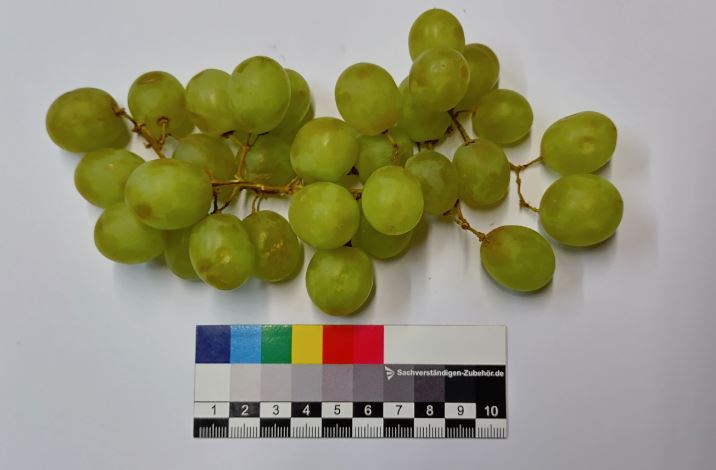
‘Timson’ A regular white, but actually green seedless grape of unusual small size. The skin is tight, the flesh juicy with generally no aftertaste. There is nothing remarkable in this grape. Origin Chile for Ocado / M&S.
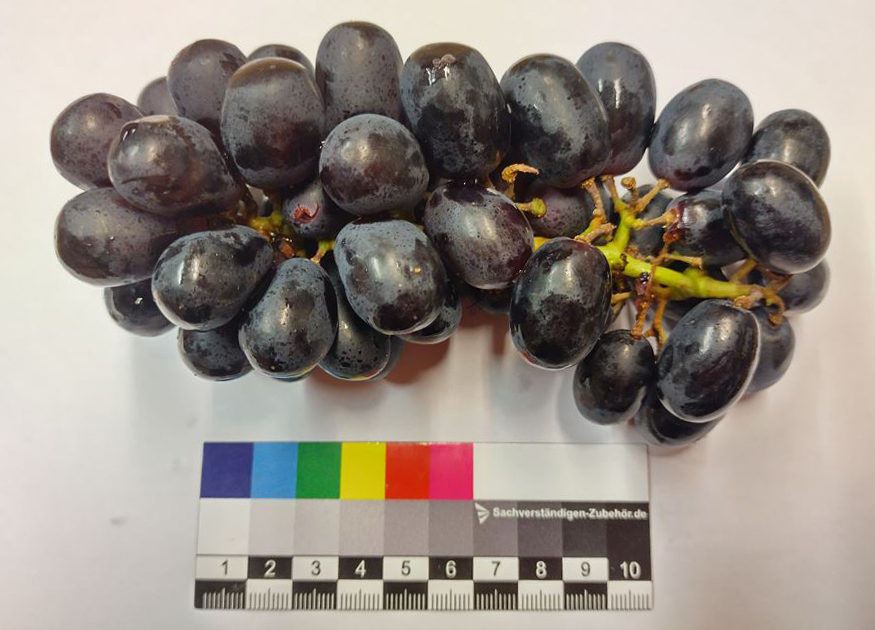
‘Vitoria’ Not to be confused with another variety called ‘Victoria’. This is a black seedless grape that comes in small bunches each of slightly elongated form. The skin is firm and contains a surprise melody of juicy flavours which all burst out when exploded. There is nothing subtle in the flavour of Vitoria; to some the gustatory surprise might be a marmite moment, far too strong and sharp, to others it is rather a squelchy mess of almost fermented grapes (perhaps this lot were). I do not think I would willingly choose this variety of grape in future. Origin: Peru for Ocado.

